You're correct. Diagrams A and B represent functions since each element in the domain corresponds to exactly one element in the range. Diagram C is not a function since the element 2 in the domain corresponds to more than one element in the range, 5 and 7.
Great job recalling the concepts of relations and functions! Now let's proceed to representing real-life situations using functions.







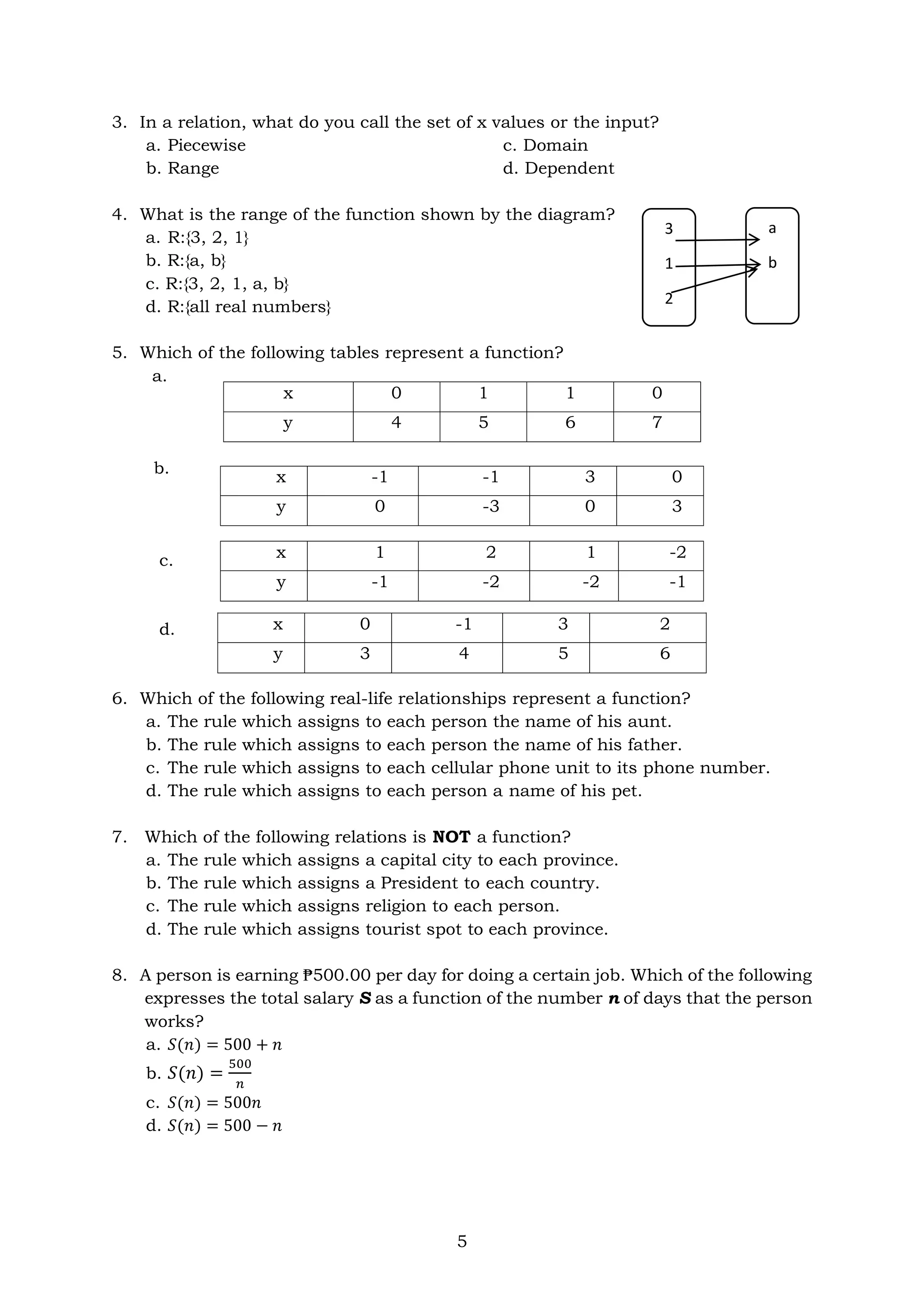


![8
Lesson
1
Representing Real-Life
Situations Using Functions
Welcome to the first lesson of your General Mathematics. This lesson will give
you the practical application of functions in a real-life scenario including the piece-
wise function. When you are in Grade 8, you already encountered relation and
function. But in this module, let’s take into a deeper sense on how this topic can be
useful in our daily life. Are you all ready?
What’s In
Before we proceed in representing real-life scenario using function, let’s go back to
where we start. What have you remembered about relations and functions?
A relation is any set of ordered pairs. The set of all first elements of the ordered
pairs is called the domain of the relation, and the set of all second elements is called
the range.
A function is a relation or rule of correspondence between two elements (domain
and range) such that each element in the domain corresponds to exactly one element
in the range.
To further understand function, let’s study the following.
Given the following ordered pairs, which relations are functions?
A = {(1,2), (2,3), (3,4), (4,5)}
B = {(3,3), (4,4), (5,5), (6,6)}
C = {(1,0), (0, 1, (-1,0), (0,-1)}
D = {(a,b), (b, c), (c,d), (a,d)}
You are right! The relations A and B are functions because each element in the
domain corresponds to a unique element in the range. Meanwhile, relations C and D
are not functions because they contain ordered pairs with the same domain [C = (0,1)
and (0,-1), D = (a,b) and (a,d)].](https://image.slidesharecdn.com/generalmathematics-230829050249-bdfea8c7/75/general-mathematics-pdf-11-2048.jpg)
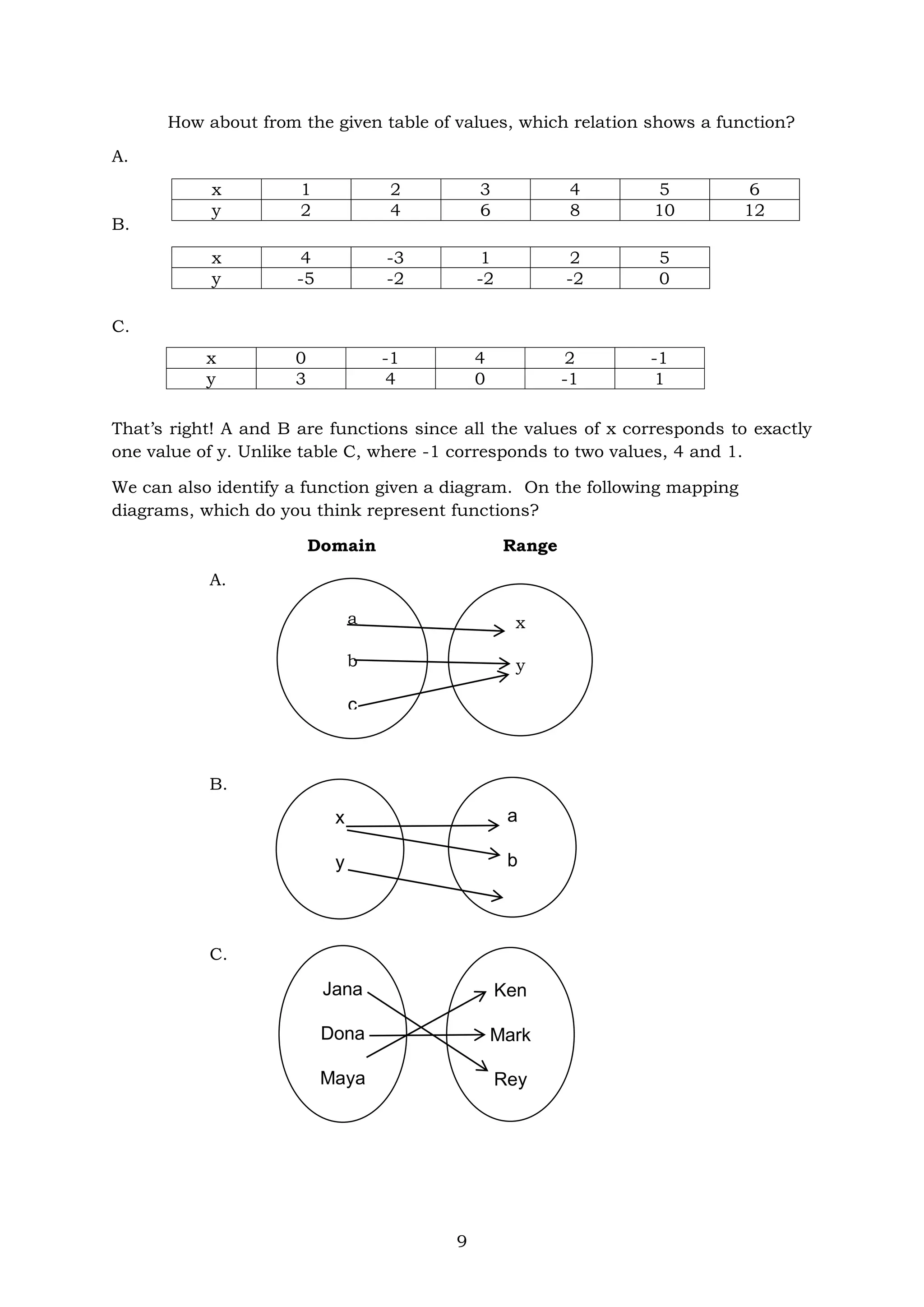
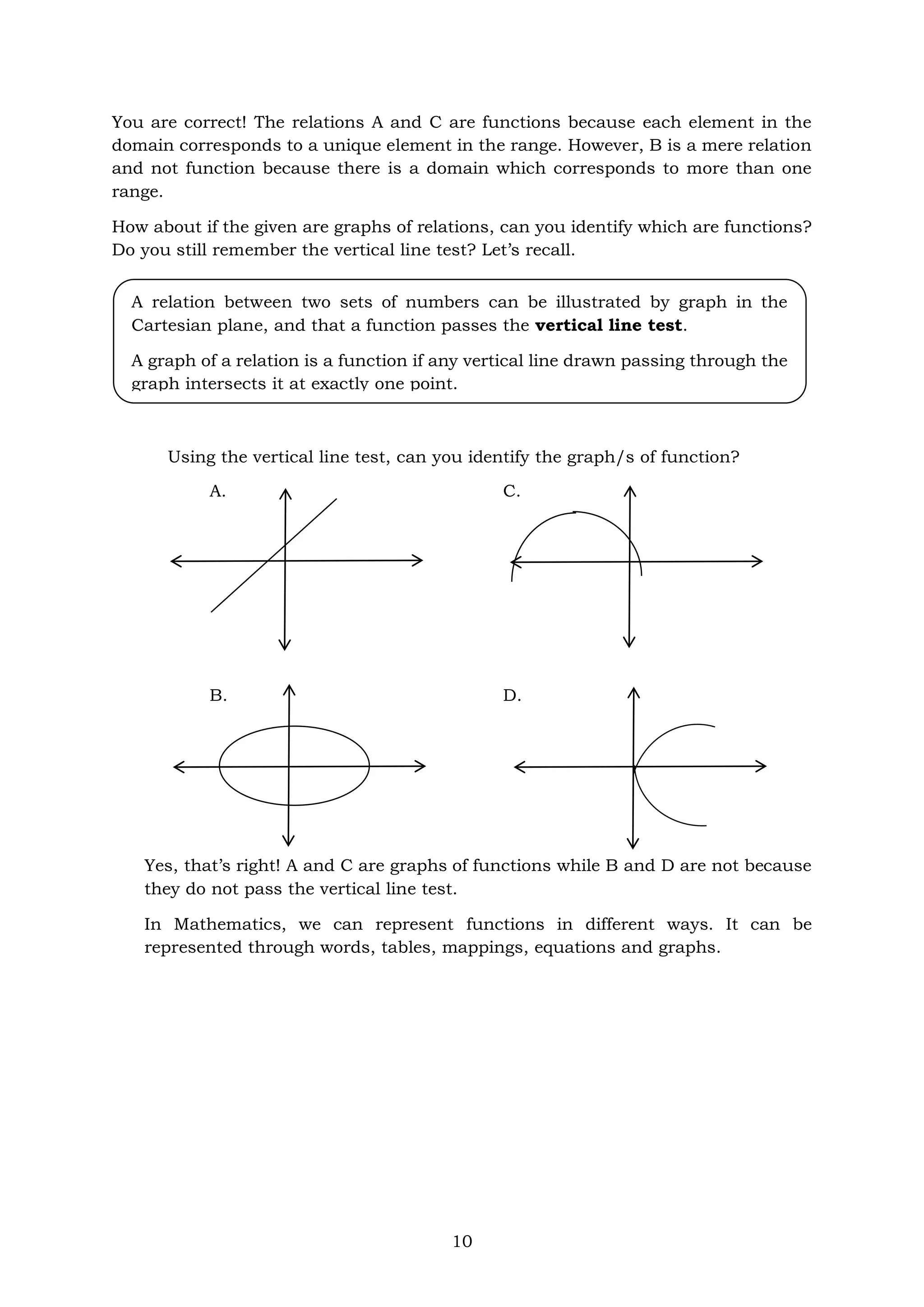



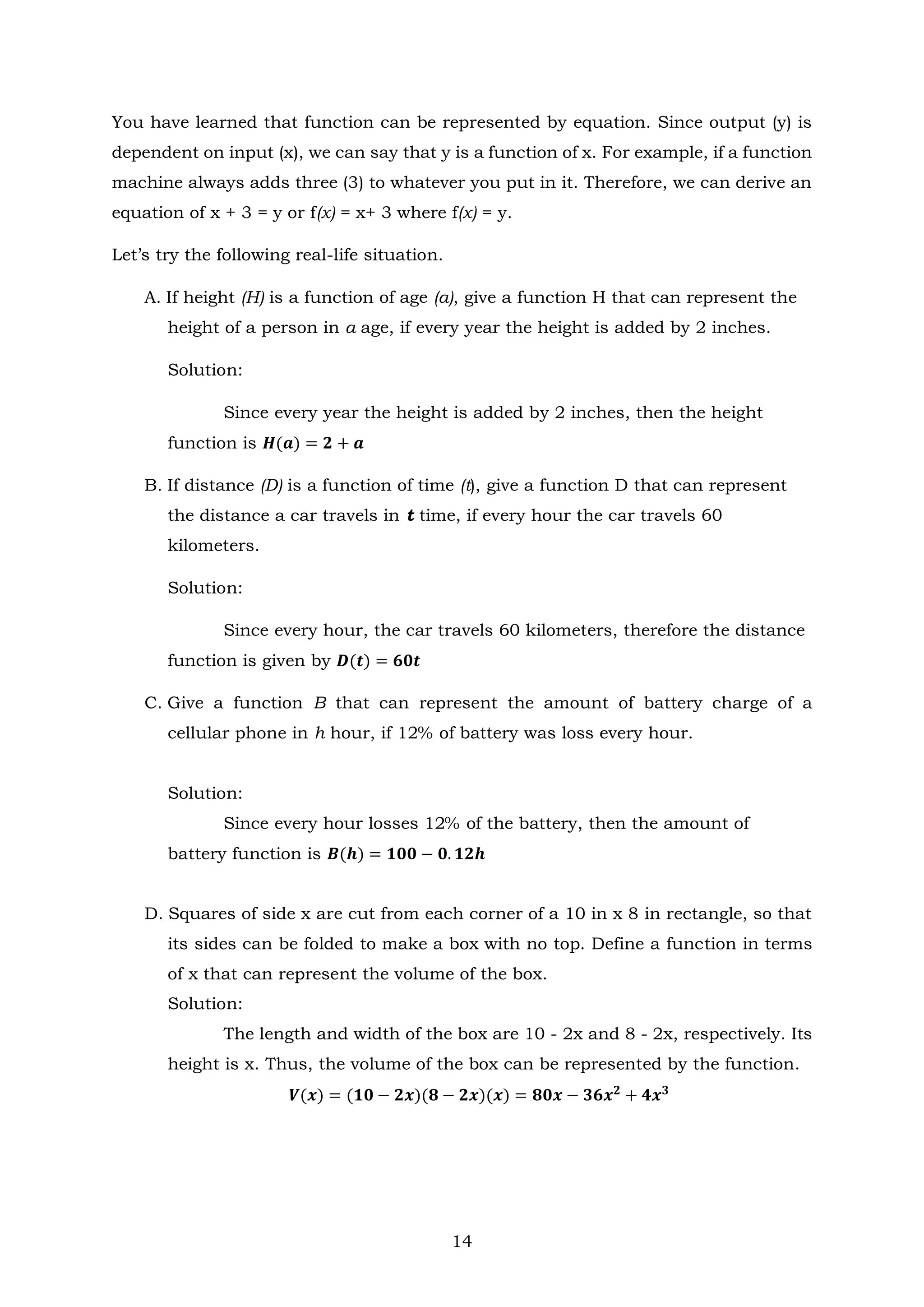

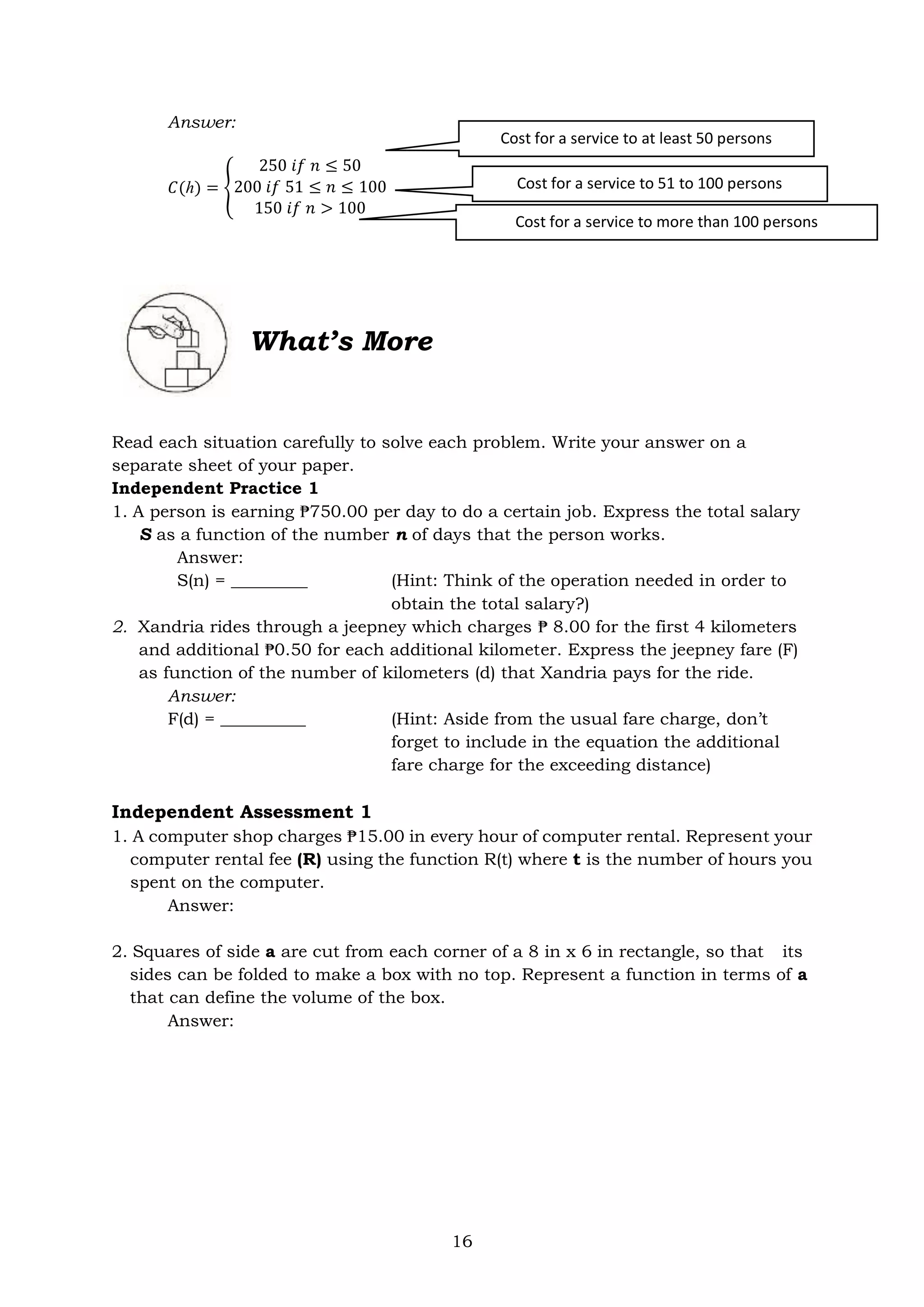
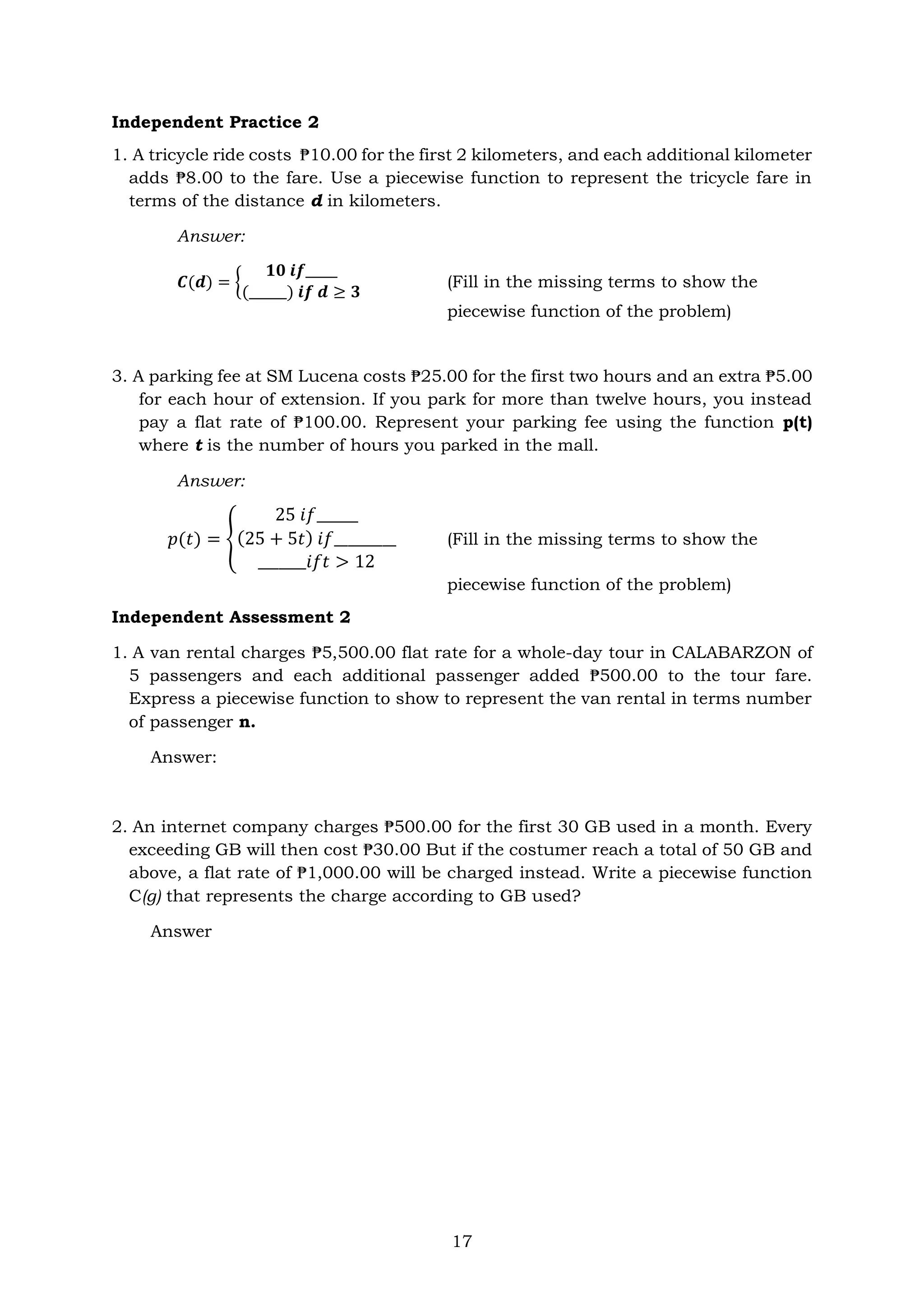






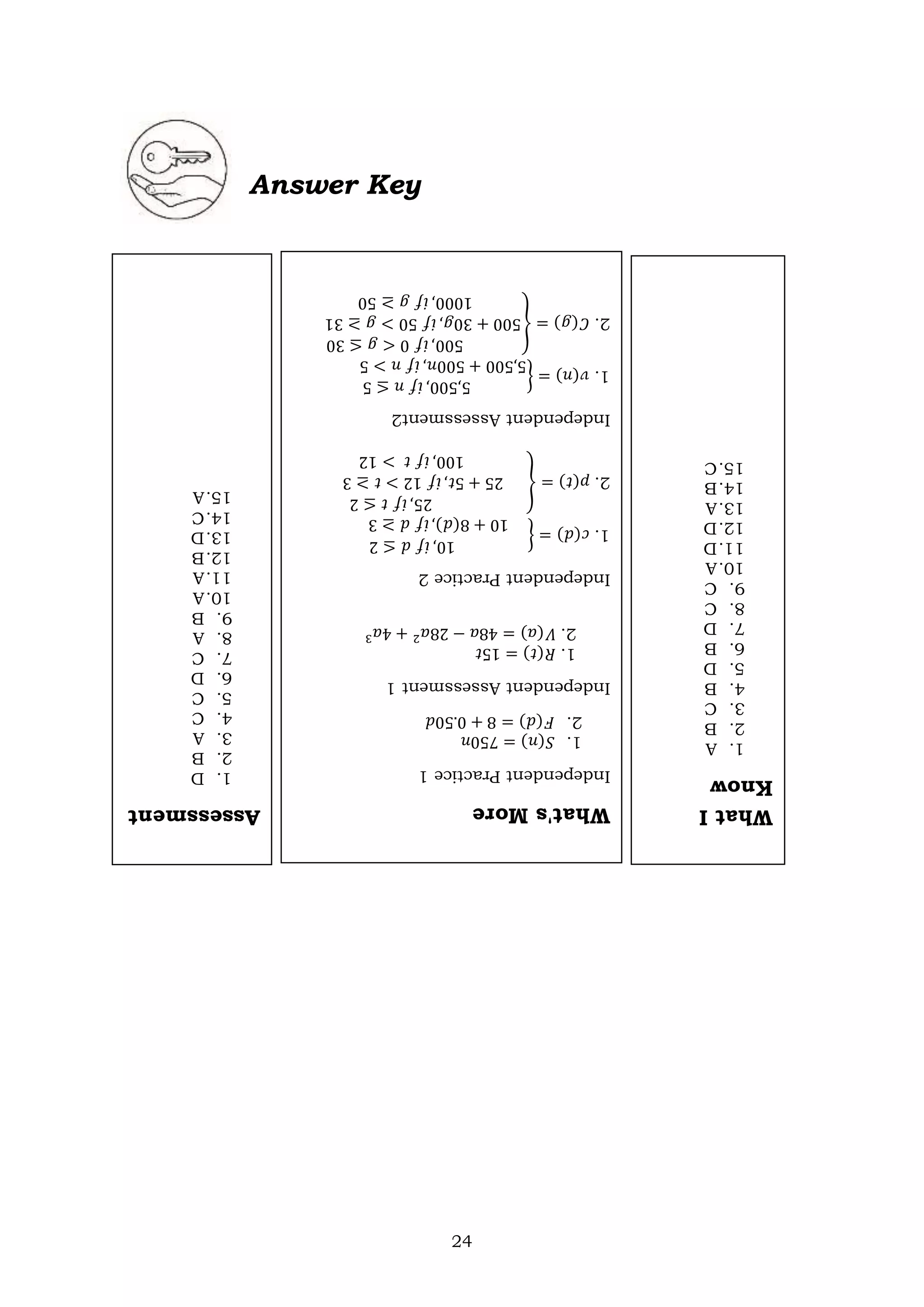









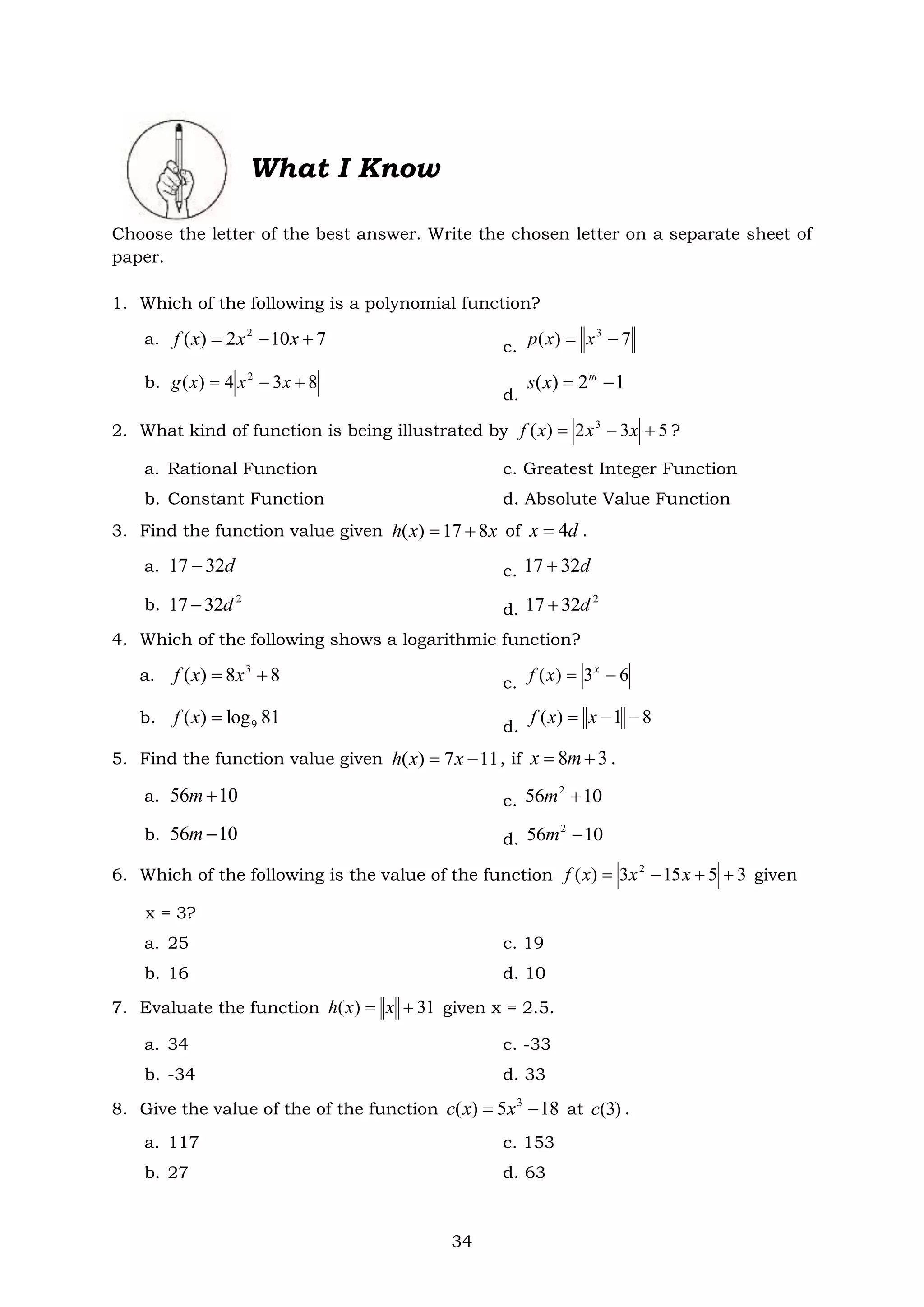


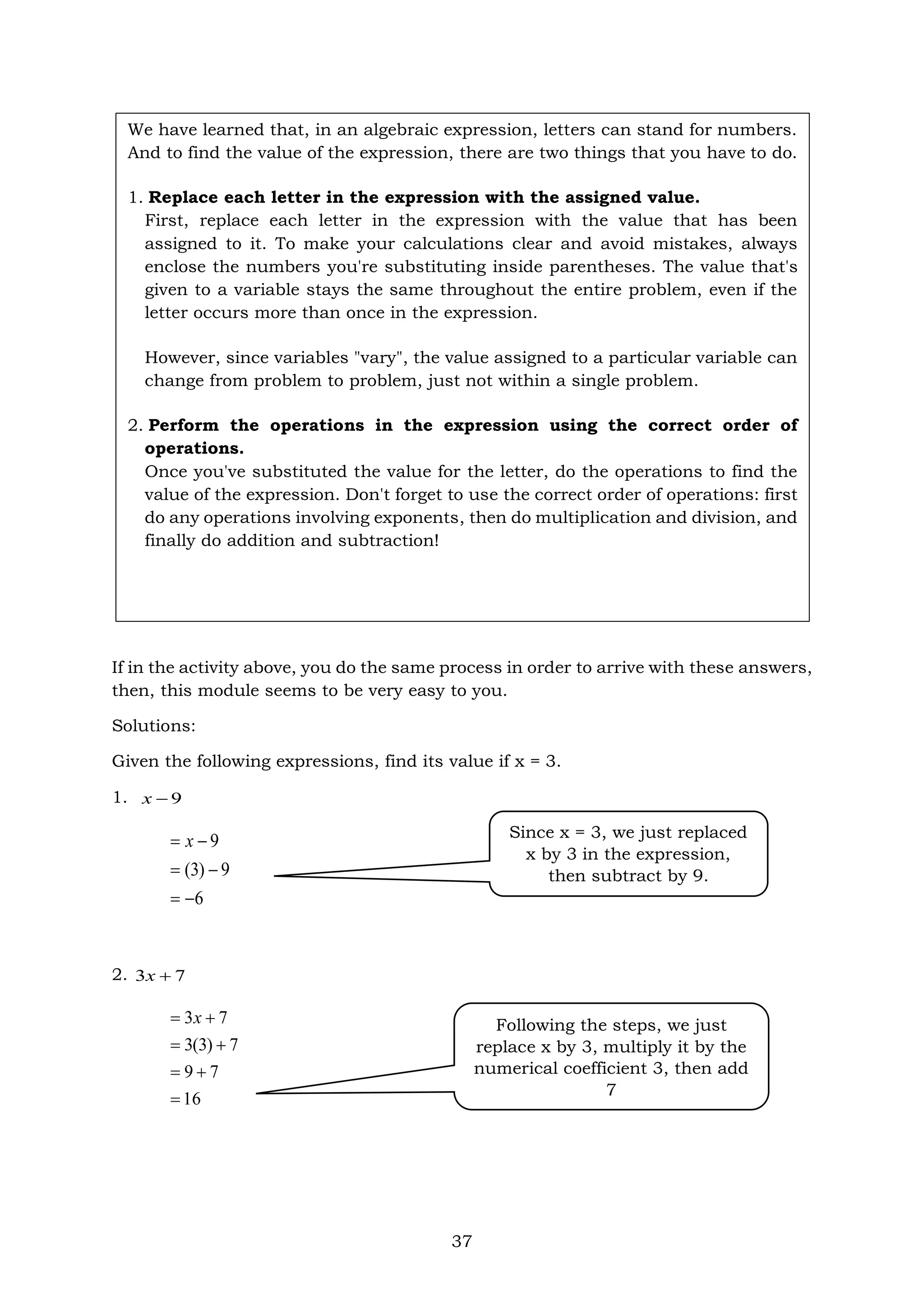
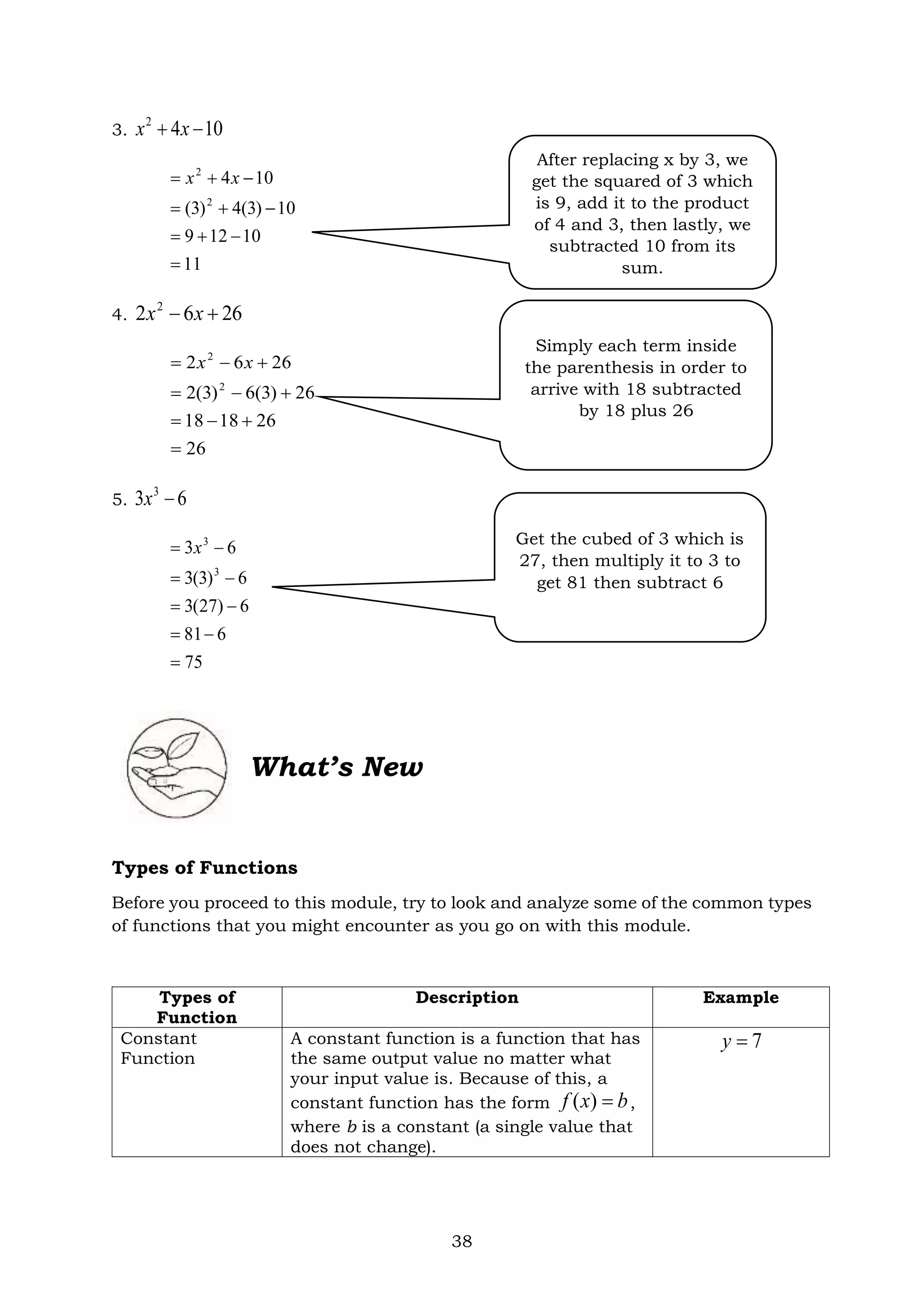
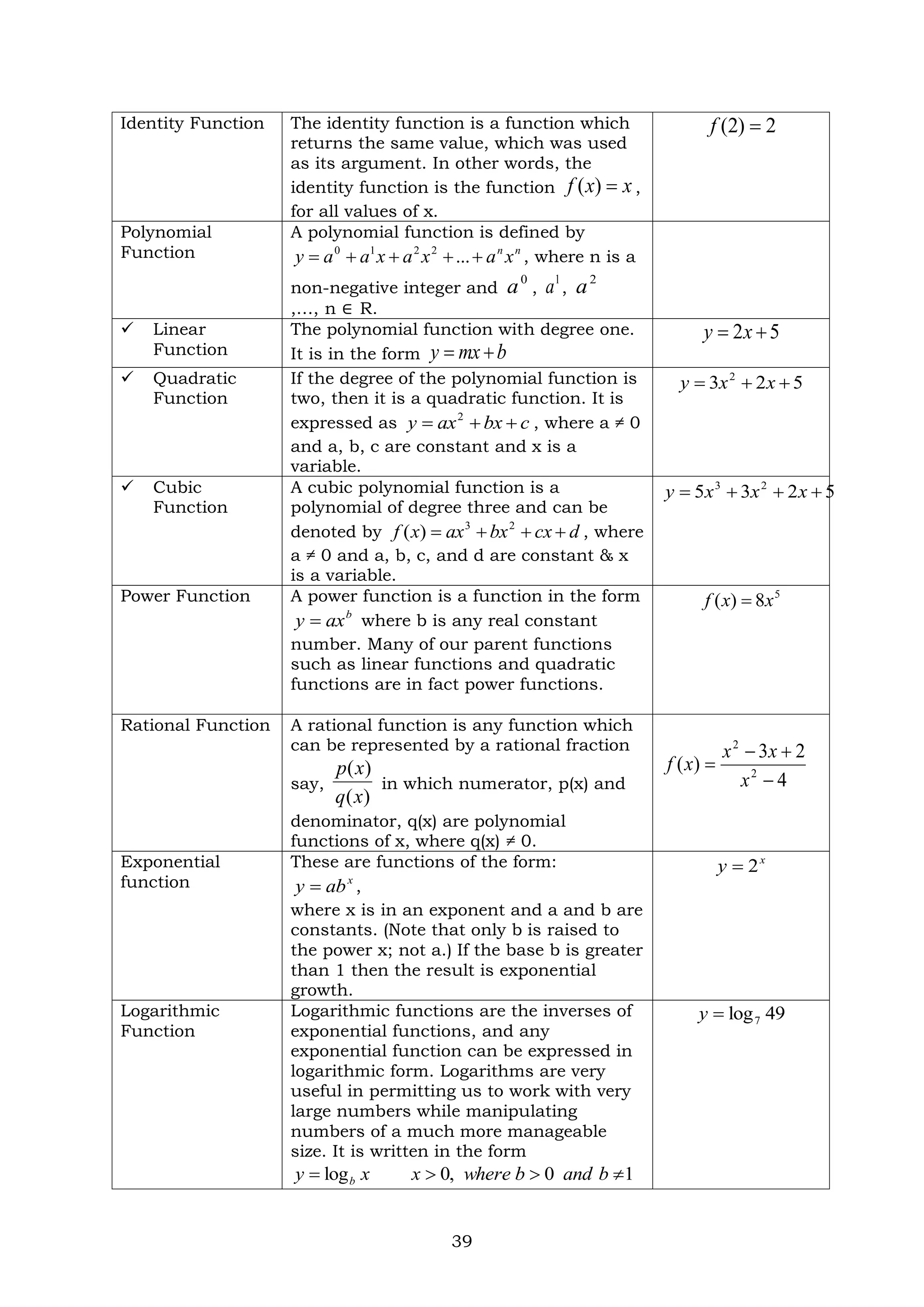
![40
Absolute Value
Function
The absolute value of any number, c is
represented in the form of |c|. If any
function f: R→ R is defined by x
x
f
)
( , it
is known as absolute value function. For
each non-negative value of x, f(x) = x and
for each negative value of x, f(x) = -x, i.e.,
f(x) = {x, if x ≥ 0; – x, if x < 0.
2
4
x
y
Greatest Integer
Function
If a function f: R→ R is defined by f(x) =
[x], x ∈ X. It round-off to the real number
to the integer less than the number.
Suppose, the given interval is in the form
of (k, k+1), the value of greatest integer
function is k which is an integer.
1
)
(
x
x
f
where x is the
greatest integer
function
What is It
Evaluating function is the process of determining the value of the function at the
number assigned to a given variable. Just like in evaluating algebraic expressions,
to evaluate function you just need to a.) replace each letter in the expression with
the assigned value and b.) perform the operations in the expression using the correct
order of operations.
Look at these examples!
Example 1: Given 4
2
)
(
x
x
f , find the value of the function if x = 3.
Solution:
4
)
3
(
2
)
3
(
f
2
)
3
(
4
6
)
3
(
f
f
Answer: Given 4
2
)
(
x
x
f , 2
)
3
(
f
Substitute 3 for x in the function.
Simplify the expression on the right
side of the equation.](https://image.slidesharecdn.com/generalmathematics-230829050249-bdfea8c7/75/general-mathematics-pdf-43-2048.jpg)
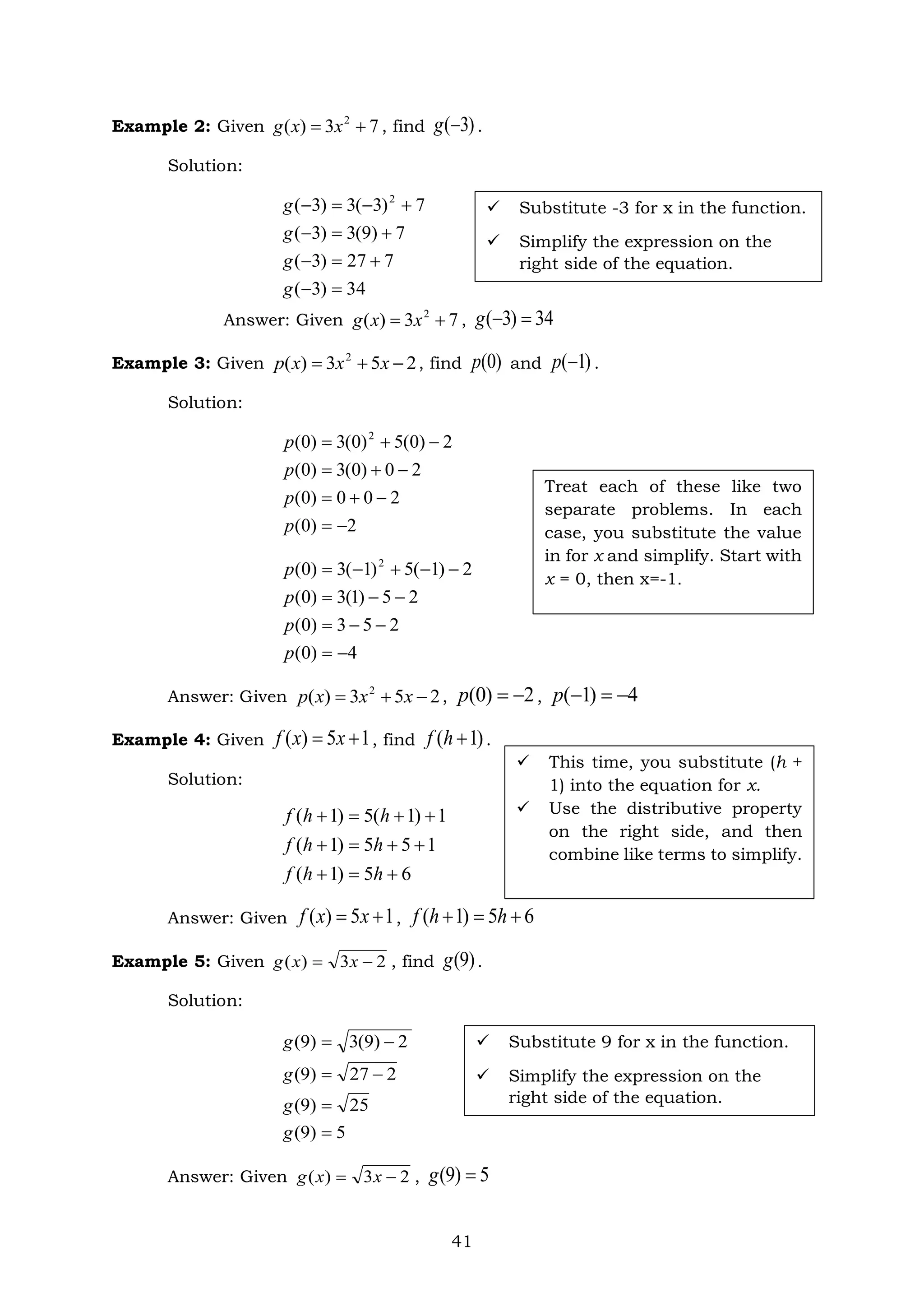
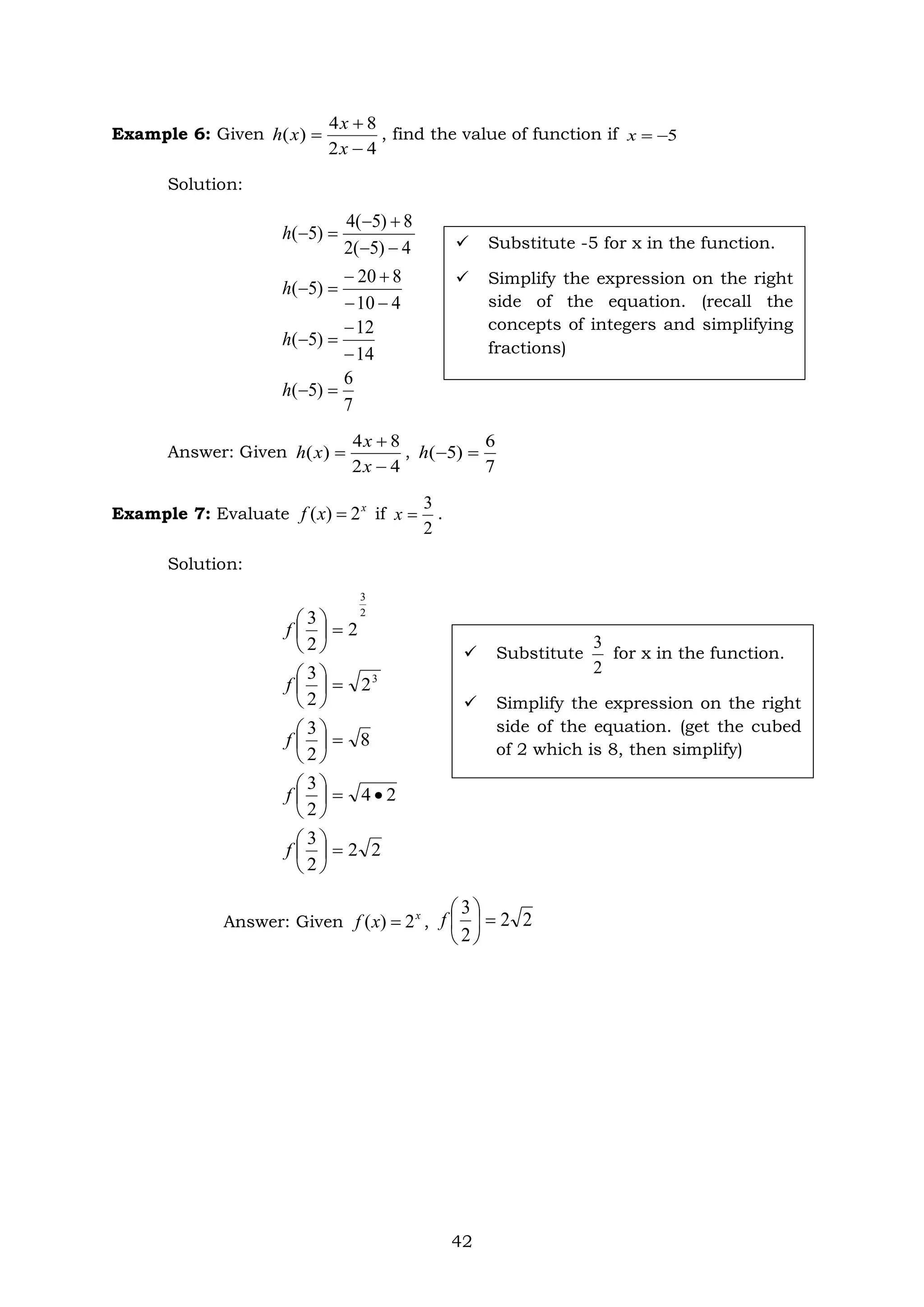

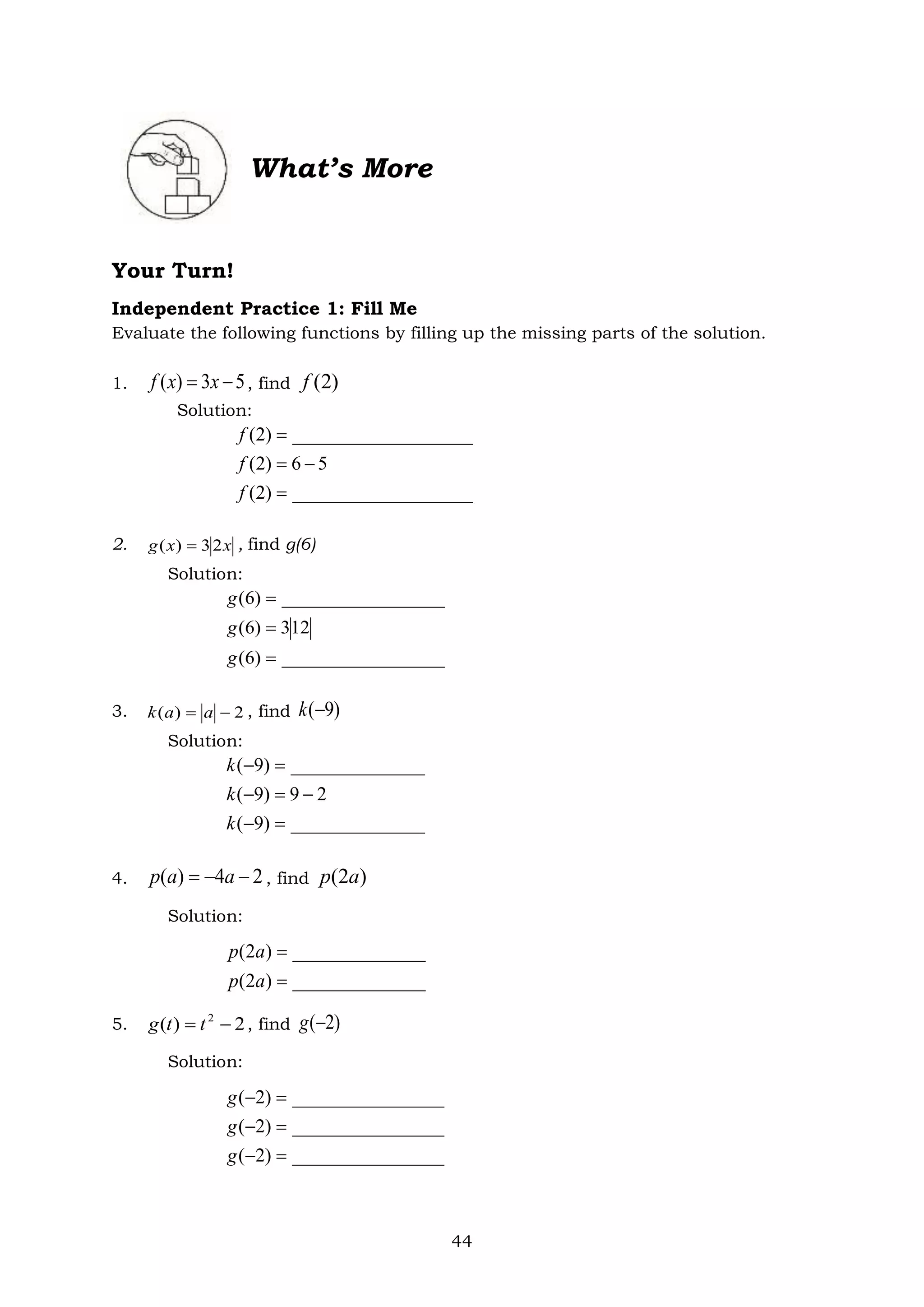
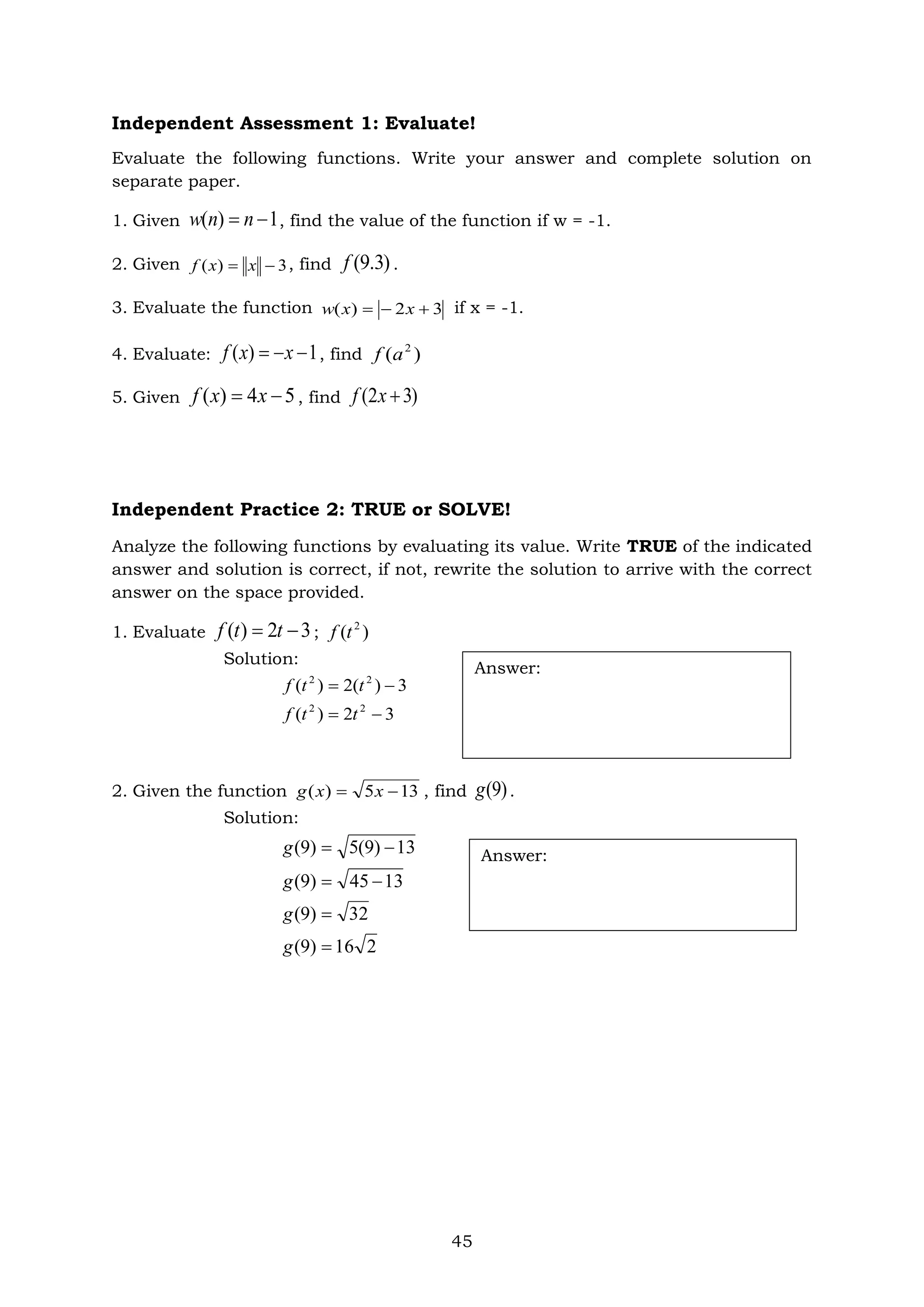
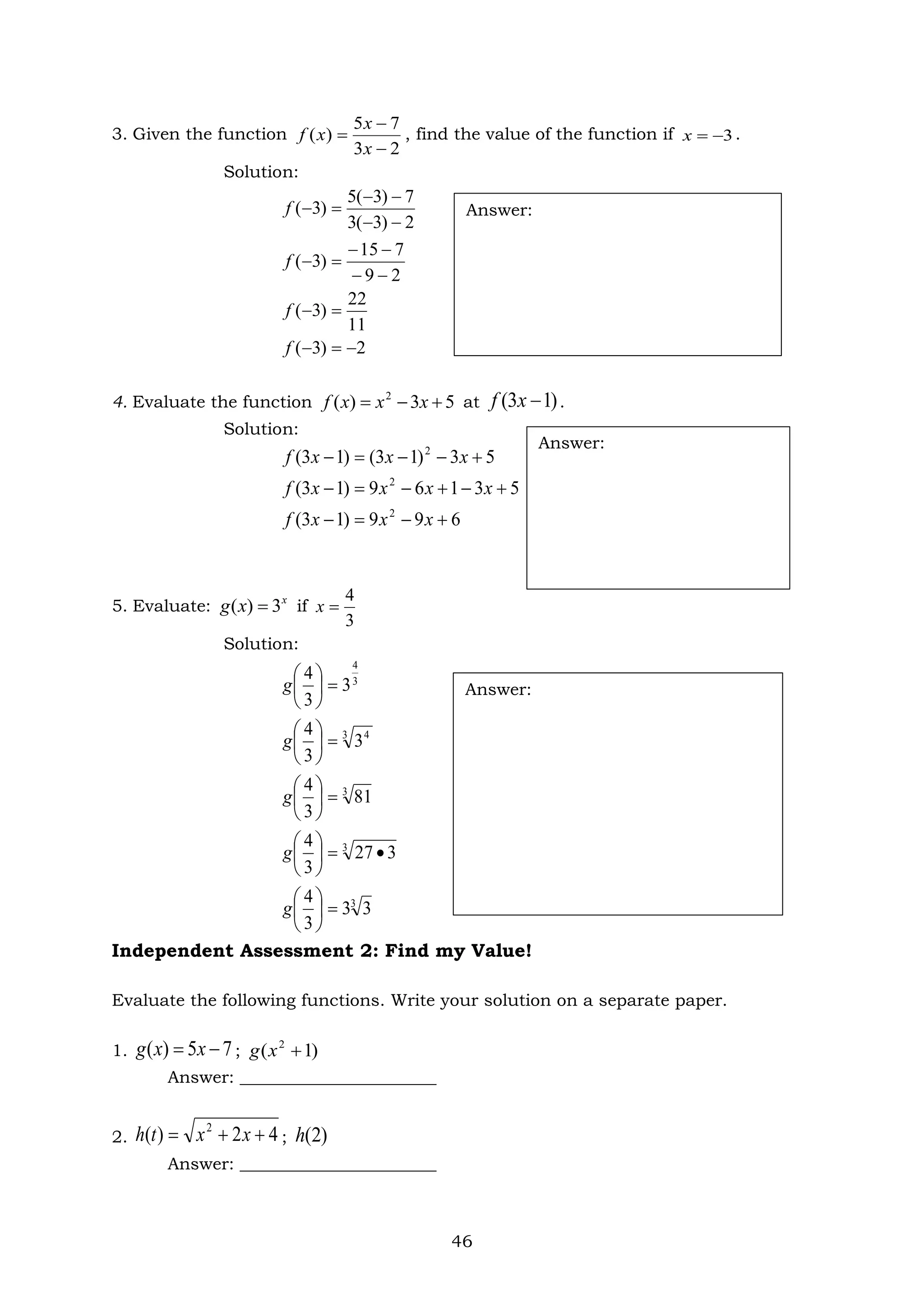



























































































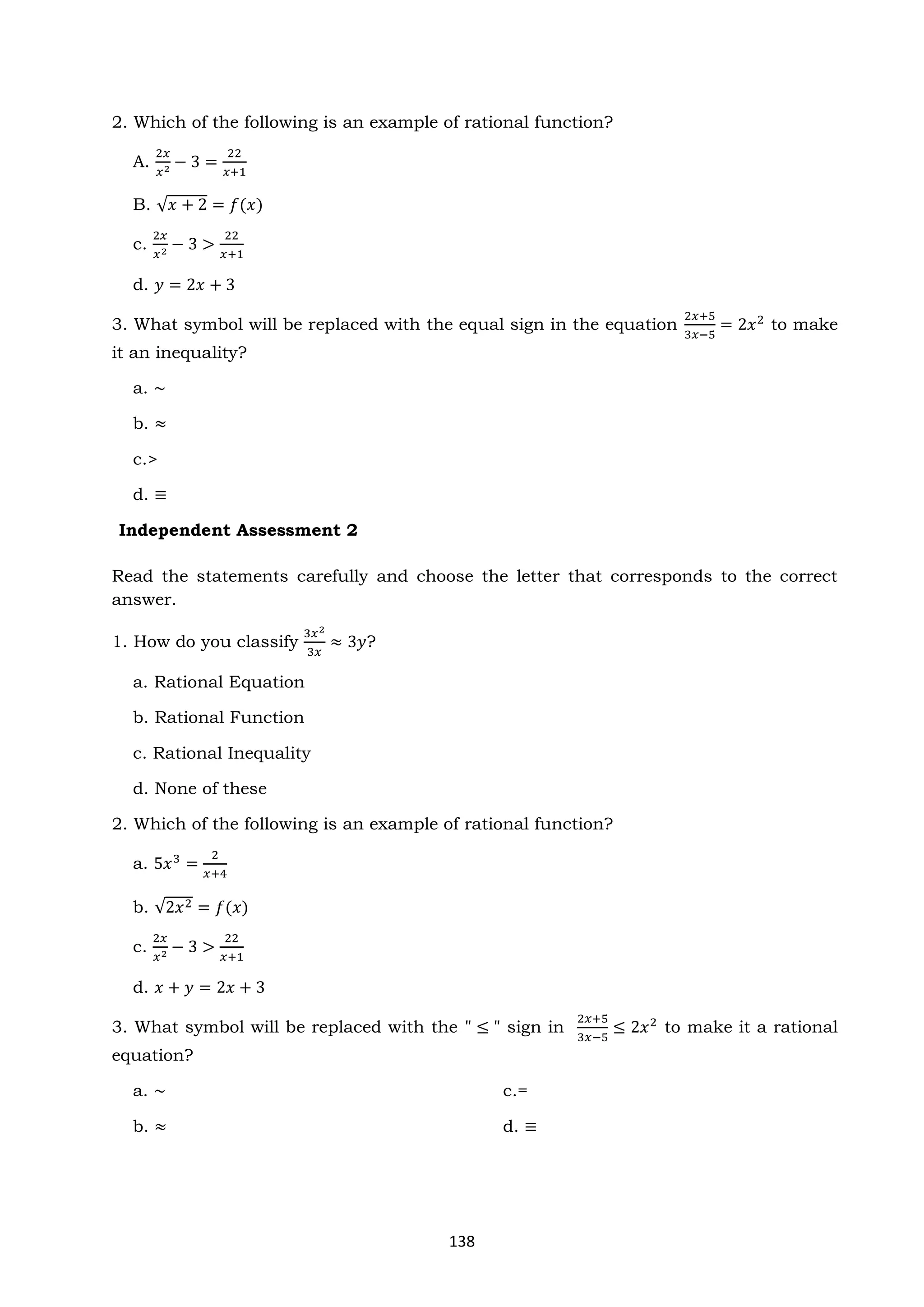












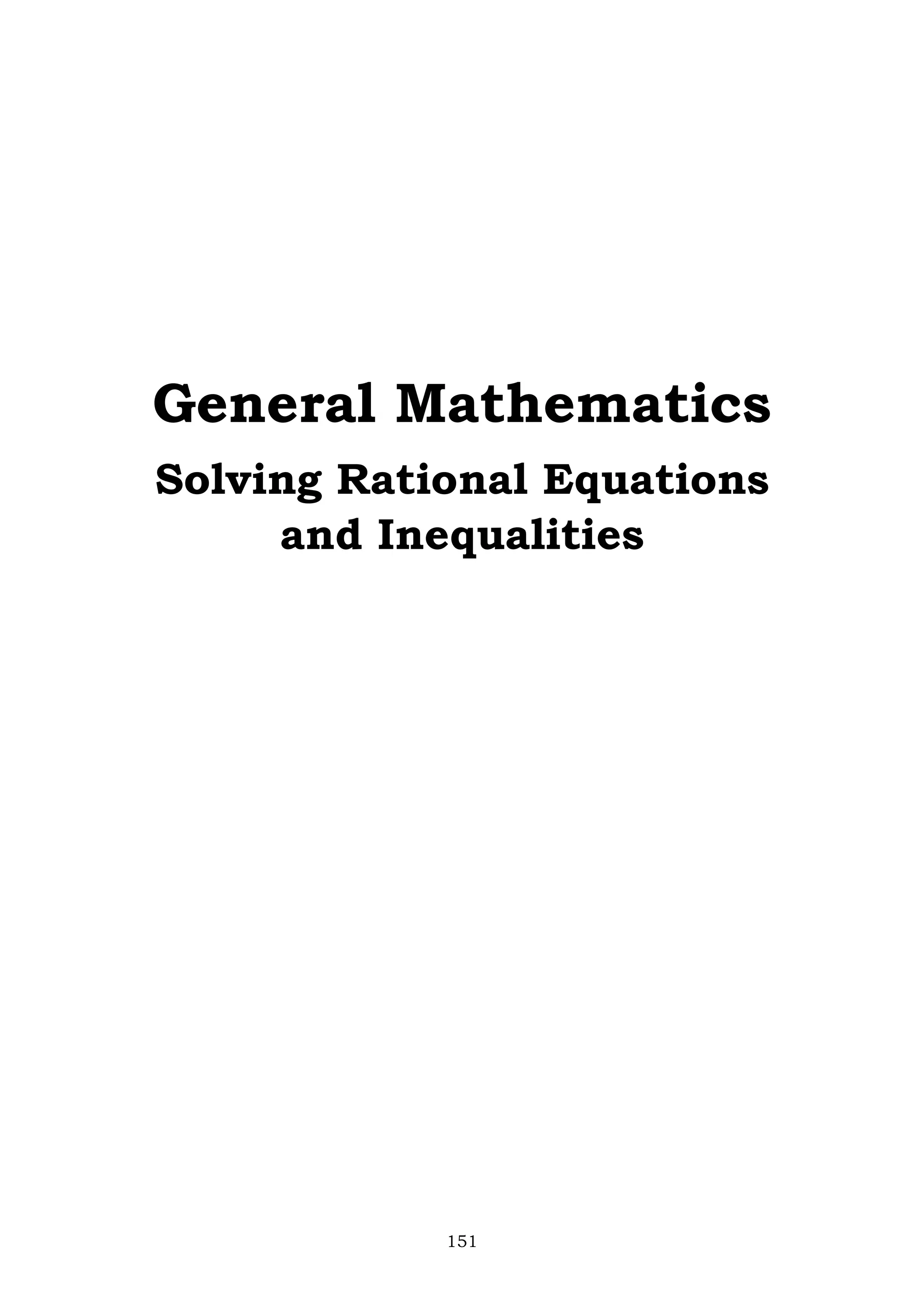





![157
10.If by solving a rational equation you obtain a number that makes an
expression in the equation undefined, then what will you do?
a. Accept even if it is untrue value.
b. Do not reject since it will satisfy the equation in a long run.
c. The number is not a real solution then discard it.
d. Continue the solution even if it will give undefined answer.
11.Which of the following is NOT an inequality sign?
a. ≤
b. √
c. ≥
d. <
12.Express the graph of solution set into interval notation.
a. {𝑥 | − 3 ≤ 𝑥 < 1}
b. {𝑥 | − 3 ≤ 𝑥 ≤ 1}
c. {𝑥 | 3 < 𝑥 ≤ 1}
d. {𝑥 | 3 ≤ 𝑥 < 1}
13. Below are the steps in solving rational inequality EXCEPT
a. Put the inequality in general form.
b. Set the numerator and denominator equal to one and solve.
c. Plot the critical values on a number line, breaking the number line into
intervals and take a test number from each interval by substituting into
the original inequality.
d. Determine if the endpoints of the intervals in the solution should be
included in the intervals.
14.Solve for the solutions of the rational inequality
(𝑥+3)
(𝑥−2)
≤ 1.
a. [∞, 2)
b. (∞, 2]
c. (-∞, 2)
d. [-∞, 2)
15.How will you know that the critical points for item no. 14 will satisfy the
inequality?
a. If it makes a true statement, then the interval from which it came is not
in the solution.
b. If it makes a false statement, then the interval from which it came is in
the solution.
c. If it makes a true statement, then the interval from which it came is in
the solution.
d. If it makes a false statement, then the interval from which it came is
either in the solution or not.](https://image.slidesharecdn.com/generalmathematics-230829050249-bdfea8c7/75/general-mathematics-pdf-160-2048.jpg)




![162
1. Solve example 2 of the rational equation by following the given steps.
Rational Equation
Example 1 Example 2
𝑥 − 3
𝑥2 − 25
+
1
𝑥 + 5
=
1
(𝑥 − 5)
2
𝑥2 − 1
−
1
𝑥 − 1
=
1
2
1. Find the Least
Common Denominator
(LCD).
LCD:
(𝑥 + 5)(𝑥 − 5)
2. Multiply both sides of
the equation by its the
LCD.
(𝑥 + 5)(𝑥 − 5)[
𝑥−3
𝑥2−25
+
1
𝑥+5
=
1
(𝑥−5)
]
3. Apply the Distributive
Property and then
simplify.
(𝑥 − 3) + 1(𝑥 − 5) = 1(𝑥 + 5)
𝑥 − 3 + 𝑥 − 5 = 𝑥 + 5
simplify:
2𝑥 − 8 = 𝑥 + 5
2𝑥 − 𝑥 = 8 + 5
𝑥 = 13
4. Find all the possible
values of x.
𝑥 = 13
5. Check each value by
substituting into original
equation and reject any
extraneous root/s
Checking:
𝑥 − 3
𝑥2 − 25
+
1
𝑥 + 5
=
1
(𝑥 − 5)
13 − 3
132 − 25
+
1
13 + 5
=
1
(13 − 5)
10
169 − 25
+
1
18
=
1
8
10
144
+
1
18
=
1
8
10 + 8
144
=
1
8
1
8
=
1
8
✓
Note: No extraneous root
2. Solve example 2 of rational inequality. You can refer to example 1 for the guided
steps.
Rational Inequality
Example 1 Example 2
3
𝑥 − 2
≤ −1
3𝑥 + 1
𝑥 − 1
≥ 2
1. Put the rational inequality
in general form.
𝑅(𝑥)
𝑄(𝑥)
> 0
where > can be replaced
by <, ≤ 𝑎𝑛𝑑 ≥
3
𝑥 − 2
+ 1 ≤ 0](https://image.slidesharecdn.com/generalmathematics-230829050249-bdfea8c7/75/general-mathematics-pdf-165-2048.jpg)

![164
when 𝑥 = 3
3
3 − 2
≤ −1
3 ≤ −1 ☓ 𝑓𝑎𝑙𝑠𝑒
6. Use interval notation or
set notation to write the
final answer.
[−1,2)
How do you find the activity? Have you enjoyed it? Did you follow the steps correctly?
The activity tells you about solving rational equations and inequalities. Yes, you read
it right. You almost got it!
Let’s check if your answers are correct and which process did you find it difficult. I
hope you enjoyed answering by your own.
Rational equation is an equation containing at least one rational expression with a
polynomial in the numerator and denominator. It can be used to solve a variety of
problems that involve rates, times and work. Using rational expressions and
equations it can help us to answer questions about how to combine workers or
machines to complete a job on schedule.
Let us use the previous activity to discuss and deepen your knowledge and skills in
solving rational equation. The first thing to be in your mind in solving rational
equation is to eliminate all the fractions.
Let us solve
2
𝑥2 − 1
−
1
𝑥 − 1
=
1
2
Step 1. You need to find the Least Common Denominator (LCD).
The LCD of the given fractions is 2(𝑥 − 1)(𝑥 + 1)
Step 2. You need to multiply LCD to both sides of the equation to eliminate the
fractions. You can also apply cross multiplication if and only if you have one
fraction equal to one fraction, that is, if the fractions are proportional. In this case
you cannot use the cross multiplication unless you simplify the left equation into a
single fraction.
2(𝑥 − 1)(𝑥 + 1) [
2
𝑥2 − 1
−
1
𝑥 − 1
=
1
2
]
What is It](https://image.slidesharecdn.com/generalmathematics-230829050249-bdfea8c7/75/general-mathematics-pdf-167-2048.jpg)



![168
b. If the test value makes the inequality FALSE, then the entire interval is not a
solution to the inequality.
Step 7. Use interval notation to write the final answer.
__________________________________________________________________________________
Let’s learn more!
Solve each rational equation and inequality.
1.
4𝑥 + 1
𝑥 + 1
− 3 =
12
𝑥2 − 1
2.
2𝑥 − 8
𝑥 − 2
≥ 0
Solution:
Rational Equation
4𝑥 + 1
𝑥 + 1
− 3 =
12
𝑥2 − 1
1. Find the Least Common
Denominator (LCD).
LCD:
(𝑥 + 1)(𝑥 − 1)
2. Multiply both sides of the equation
by its the LCD.
(𝑥 + 1)(𝑥 − 1)[
4𝑥 + 1
𝑥 + 1
− 3 =
12
𝑥2 − 1
]
3. Apply the Distributive Property and
then simplify.
(𝑥 − 1)(4𝑥 + 1) − 3(𝑥 + 1)(𝑥 − 1) = 12
simplify:
4𝑥2 − 3𝑥 − 1 − 3𝑥2 + 3 = 12
𝑥2
− 3𝑥 + 2 = 12
𝑥2 − 3𝑥 − 10 = 0
Factor (𝑥 − 5)(𝑥 + 2) = 0
4. Find all the possible values of x.
𝑥 − 5 = 0 𝑥 = 5
𝑥 + 2 = 0 𝑥 = −2
5. Check each value by substituting
into original equation and reject any
extraneous root/s
Checking:
4𝑥 + 1
𝑥 + 1
− 3 =
12
𝑥2 − 1
when 𝑥 = 5
4(5) + 1
5 + 1
− 3 =
12
52 − 1
21
6
− 3 =
12
24
(−∞, −3] ∪ (1, ∞)](https://image.slidesharecdn.com/generalmathematics-230829050249-bdfea8c7/75/general-mathematics-pdf-171-2048.jpg)





![174
Activity 2
Solve each problem below and choose the letter that corresponds to the solution to
each problem. Place the correct answer in the corresponding lines.
What did the bible verses 1John 4:7-21 is all about?
______ ______ ______ ______ ______ ______ ______ ______ ______
1 2 3 4 5 6 7 8 9
1.
𝑥+2
3
=
2𝑥−4
2
2.
7
4𝑥
−
3
𝑥2 =
1
2𝑥2
3.
2𝑥
𝑥+1
+
5
2𝑥
= 2
4.
𝑥2−1
𝑥−3
=
8
𝑥−3
5.
1
𝑥−6
+
𝑥
𝑥−2
=
4
𝑥2−8𝑥+12
6.
5𝑥
𝑥−1
< 4
7.
𝑥
𝑥−2
− 7 =
2
𝑥−2
8.
𝑥2+𝑥−12
𝑥−1
≤ 0
9.
3𝑥+1
𝑥−2
≥ 5
What I Have Learned
Complete the following statements by writing the correct word or words and
formulas.
1. A ________________________ is an equation containing at least one rational
expression with a polynomial in the numerator and denominator. 2. To determine if
the endpoints of the intervals in the solution should be included
or not you need to _____________________ the critical values to the inequality.
3. In order to get the critical values you need to set __________________________ and
_________________________ equal to zero.
4. The first step in solving rational inequality is to put the inequality in general form
where in one side must always be ____________________________ and the other side
is in a _________________________ fraction.
A. -3
C. -1 and 6
D. -5
E. (2,
11
2
]
G. 4
I. 3
L. (-4, 1)
N. -3 and 3
O. 2
S. -1
V. (-∞, -4] ∪ (1, 3]
Y. (-∞, -4) ∪ [1, 3)](https://image.slidesharecdn.com/generalmathematics-230829050249-bdfea8c7/75/general-mathematics-pdf-177-2048.jpg)


![177
8. What are the critical values in the given rational inequality?
a. 𝑥 = −2 𝑎𝑛𝑑 8
b. 𝑥 = −2 𝑎𝑛𝑑 − 8
c. 𝑥 = −2 𝑎𝑛𝑑 12
d. 𝑥 = −2 𝑎𝑛𝑑 − 12
9. Which of the critical value or values is/are included as endpoints of the
intervals?
a. −2
b. 2
c. −8
d. 8
10.Which of the following is the solution in the given inequality?
a. (−∞, −2) ∪ (8, ∞)
b. (−∞, −2] ∪ [8, ∞)
c. (−∞, −2) ∪ [8, ∞)
d. (−∞, −2) ∪ [−8, ∞)
For items 11-13, solve for the solutions of the following rational equations.
11.
2
𝑥+2
+
1
𝑥−2
=
3
𝑥
a. 6
b. −6
c. 8
d. −8
12.
8
𝑥2 + 1 =
9
𝑥
a. −1 𝑎𝑛𝑑 − 8
b. 1 𝑎𝑛𝑑 8
c. −1 𝑎𝑛𝑑 8
d. 1 𝑎𝑛𝑑 − 8
13.
1
𝑥2 − 16 = 0
a. ±1
b. ±2
c. ±
1
2
d. ±
1
4
For items 14-15, solve for the solutions of the following rational equations.](https://image.slidesharecdn.com/generalmathematics-230829050249-bdfea8c7/75/general-mathematics-pdf-180-2048.jpg)
![178
14.
5
𝑥−3
>
3
𝑥+1
a. (−∞, −7) ∪ (−1, ∞)
b. (−∞, −1) ∪ (3, ∞)
c. (−7, −1) ∪ (3, ∞)
d. (−7, −1] ∪ [3, ∞)
15.
(𝑥−3)(𝑥+2)
𝑥−1
≤ 0
a. (−∞, −2) ∪ (1,3]
b. (−∞, −2] ∪ (1,3]
c. (−∞, −2] ∪ [1,3)
d. (−∞, −2) ∪ [1,3)
Additional Activities
Practice Worksheet: Solving Rational Equations and Inequalities
Solve each equation. Check extraneous solutions for rational equations. Write your
answer in interval notation for rational inequalities.
LEVEL 1
1.
8
𝑥 + 1
=
4
3
2.
2𝑥 + 3 =
𝑥
4
3.
𝑥 − 4
𝑥 + 5
≤ 0
4.
𝑥 + 3
3𝑥 − 6
> 0](https://image.slidesharecdn.com/generalmathematics-230829050249-bdfea8c7/75/general-mathematics-pdf-181-2048.jpg)


![181
Answer Key
What
I
Know
1.
B
2.
A
3.
C
4.
B
5.
D
6.
A
7.
A
8.
B
9.
D
10.
C
11.
B
12.
A
13.
B
14.
D
15.
C
What's
More
1.
G
2.
O
3.
D
4.
I
5.
S
6.
L
7.
O
8.
V
9.
E
What
I
Have
Learned
1.
Extraneous
solutions
2.
Substitute
3.
Numerator,
denominator
4.
zero,
single
5.
true
What
I
Can
Do
It
will
take
3
hours
and
45
minutes
for
the
two
laboratory
technicians
to
finish
150
samples
of
specimens
.
Assessment
1.
B
2.
C
3.
C
4.
D
5.
B
6.
D
7.
A
8.
A
9.
D
10.
C
11.
A
12.
B
13.
D
14.
C
15.
A
Additional
Activities
1.
𝑥
=
5
2.
𝑥
=
−
12
7
3.
(−5,4]
4.
(-∞,
−3)
∪
(3,
∞)
5.
𝑥
=
13
27
6.
(−2,
2)
7.
𝑥
=
−8
8.
𝑥
=
2
9.
ቂ−
13
5
,
−
2
3
ቁ
10.
(-∞,
−6)
∪
[−
4
5
,
∞)
11.
𝑥
=
−
1
5
12.
(−2,
−1)
∪
(0,
1)
13.
𝑥
=
−2
𝑎𝑛𝑑
5
14.
𝑥
=
7
2
15.
(−1,1)
∪
[2
,
∞)
16.
(−∞,
−7)
∪
(3,5)
∪
(5,
∞)
17.
𝑥
=
7
18.
ቀ−
3
2
,
−
4
3
ቁ
∪
(−
1
2
,
1
2
)](https://image.slidesharecdn.com/generalmathematics-230829050249-bdfea8c7/75/general-mathematics-pdf-184-2048.jpg)













![195
13. If Lina spends 15hours on a student and another 13 hours for another student
in a month, how much will she earn? Write an equation that will suit best the
situation
a. 𝑓𝑒𝑒 = [500 − 200(15)] + [500 − 200(13)]
b. 𝑓𝑒𝑒 = [500 + 200(15)] + [500 + 200(13)]
c. 𝑓𝑒𝑒 = [500(15) + 200] + [500(13) + 200]
d. 𝑓𝑒𝑒 = [500(15) − 200] + [500(13) − 200]
For numbers 14 and 15, refer to the problem below.
There are 1,200 freshmen and 1,500 sophomores at SSG Election Meeting de Avance
at noon. After 12 p.m., 20 freshmen arrive at the gymnasium every five minutes while
15 sophomores leave the gymnasium.
14. Which equation best describes the total number of students who attended the
SSG Election Meeting de Avance?
a. 𝑦 = [1200𝑥 + 20] + [1500𝑥 − 15]
b. 𝑦 = [1200 + 20𝑥] + [1500 − 15𝑥]
c. 𝑦 = [1200𝑥 − 20] + [1500𝑥 + 15]
d. 𝑦 = [1200 − 20𝑥] + [1500 + 15𝑥]
15. Simplifying the answer in number 14, we can get
a. 𝑦 = 2700𝑥 + 5
b. 𝑦 = 2700 + 5𝑥
c. 𝑦 = 2700𝑥 − 5
d. 𝑦 = 2700 − 5𝑥
Lesson
1
Representations of Rational
Functions
This lesson is about representations of rational function in different ways. We will
deal with the application of rational functions that may involve the number of
persons who can do a task in a certain amount of time. We can handle these
applications involving work in a manner similar to the method we used to solve
distance, speed, and time problems.](https://image.slidesharecdn.com/generalmathematics-230829050249-bdfea8c7/75/general-mathematics-pdf-198-2048.jpg)


























































































































































































![382
Lesson
1
Finds the Domain and
Range of an Inverse
Function
Start Lesson 1 of this module by assessing your knowledge of the basic skills in finding
the inverse of a function. This knowledge and skill will help you understand easily on
how to find the domain and range of an inverse function. Seek the assistance of your
teacher if you encounter any difficulty. This topic is about finding the domain and range
of an inverse function.
What’s In
Recall that a function has an inverse if and only if it is one-to-one and every one-to-one
function has a unique inverse function.
Below are the steps in solving for the inverse of a function:
a. Write the function in the form y=f(x);
b. Interchange the x and y variables;
c. Solve for y in terms of x;
d. Replace y by f-1(x);
e. Verify if f and f-1 are inverse functions.
Example 1: Find the inverse of 𝑓(𝑥) = 3𝑥 − 8 .
Solution: The equation of a function is 𝑦 = 3𝑥 − 8. Interchanging the x and y variables,
we get 𝑥 = 3𝑦 − 8.
Solving y for x: 3𝑦 = 𝑥 + 8
𝑦 =
𝑥+8
3
Therefore, the inverse of 𝑓(𝑥) = 3𝑥 − 8 is 𝑓−1(𝑥) =
𝑥+8
3
To verify if f and f-1 are inverse functions:
𝑓[𝑓−1(𝑥)] = 3 (
𝑥+8
3
) − 8 𝑓−1[𝑓(𝑥)] =
3𝑥−8+8
3
= x+8 =
3𝑥
3
=x = x
Therefore, f-1 is the inverse of f.](https://image.slidesharecdn.com/generalmathematics-230829050249-bdfea8c7/75/general-mathematics-pdf-385-2048.jpg)
![383
Example 2: Find the inverse of 𝑓(𝑥) = √2𝑥 + 1 .
Solution: The equation of a function is 𝑦 = √2𝑥 + 1. Interchanging the x and y variables,
we get 𝑥 = √2𝑦 + 1.
Solving y for x: 2𝑦 = 𝑥2
− 1
𝑦 =
𝑥2−1
2
Therefore, the inverse of 𝑓(𝑥) = √2𝑥 + 1 is 𝑓−1(𝑥) =
𝑥2−1
2
To verify if f and f-1 are inverse functions:
𝑓[𝑓−1(𝑥)] = √2 (
𝑥2−1
2
) + 1 𝑓−1[𝑓(𝑥)] =
(√2𝑥+1)
2
−1
2
= √𝑥2 − 1 + 1 =
2𝑥+1−1
2
=x = x
Therefore, f-1 is the inverse of f.
Example 3: Find the inverse of 𝑓(𝑥) = 𝑥2
+ 4 .
Solution: The equation of a function is 𝑦 = 𝑥2
+ 4. Interchanging the x and y variables,
we get 𝑥 = 𝑦2
+ 4.
Solving y for x: 𝑦2
= 𝑥 − 4
𝑦 = √𝑥 − 4
Therefore, the inverse of 𝑓(𝑥) = 𝑥2
+ 4 is 𝑓−1(𝑥) = √𝑥 − 4
To verify if f and f-1 are inverse functions:
𝑓[𝑓−1(𝑥)] = (√𝑥 − 4 )2
+ 4 𝑓−1[𝑓(𝑥)] = √𝑥2 + 4 − 4
= 𝑥 − 4 + 4 = √𝑥2
=x = x
Therefore, f-1 is the inverse of f.
Notes to the Teacher
The notation f-1 is used to represent the inverse of a function f.
To verify that the f and f-1 are inverse functions:
and](https://image.slidesharecdn.com/generalmathematics-230829050249-bdfea8c7/75/general-mathematics-pdf-386-2048.jpg)




![388
To verify if f and f-1 are inverse functions:
𝑓[𝑓−1(𝑥)] = 3(𝑥 − 12 /3) + 12 𝑓−1[𝑓(𝑥)] = (3𝑥 − 12 − 12)/3
= x-12+12 = 3x/3
=x = x
Therefore, f-1 is the inverse of f.
Example 3. Find the domain and range of 𝒇(𝒙) = √𝒙 + 𝟐 and its inverse.
Solution:
Let 𝒚 = √𝒙 + 𝟐
Interchange x and y: 𝒙 = √𝒚 + 𝟐
Solve for y.
𝒙𝟐
= 𝒚 + 𝟐
𝒚 = 𝒙𝟐
− 𝟐
𝒇−𝟏(𝒙) = 𝒙𝟐
− 𝟐
Determine the domain and range of f and f-1.
You have 𝒇(𝒙) = √𝒙 + 𝟐 a and 𝒇−𝟏(𝒙) = 𝒙𝟐
− 𝟐
Domain of (f) ={𝒙 ≥ −𝟐} Range of (f)= {𝒚 ≥ 𝟎}
Domain of (f-1) = {𝒙 ≥ 𝟎} Range of (f-1) ={≥ −𝟐}
To verify if f and f-1 are inverse functions:
𝑓[𝑓−1(𝑥)] = √𝑥2 − 2 + 2 𝑓−1[𝑓(𝑥)] = (√𝑥 + 2)
2
− 2
= √𝑥2 = x+2-2
=x = x
Therefore, f-1 is the inverse of f.
Example 4. Consider f(𝒙) = 𝒙𝟐
− 𝟓. Find the inverse and its domain and range.
Solution:
Let 𝒚 = 𝒙𝟐
− 𝟓
Interchange x and y: 𝒙 = 𝒚𝟐
− 𝟓
Solve for y.
𝒚𝟐 = 𝒙 + 𝟓
𝒚 = √𝒙 + 𝟓
𝒇−𝟏(𝒙) = √𝒙 + 𝟓
Determine the domain and range of f and f-1.
You have 𝒇(𝒙) = 𝒙𝟐
− 𝟓 and 𝒇−𝟏(𝒙) = √𝒙 + 𝟓
Domain of (f ) ={𝒙 𝝐 𝑹} Range of (f)= {𝒚 > −𝟓}
Domain of (f-1 ) = {𝒙 > −𝟓} Range of (f-1) ={𝒚 𝝐 𝑹}](https://image.slidesharecdn.com/generalmathematics-230829050249-bdfea8c7/75/general-mathematics-pdf-391-2048.jpg)
![389
To verify if f and f-1 are inverse functions:
𝑓−1[𝑓(𝑥)] = (√𝑥 + 5)
2
− 5 𝑓[𝑓−1(𝑥)] = √𝑥2 − 5 + 5
= x+5-5 = √𝑥2
=x = x
Therefore, f-1 is the inverse of f.
What’s More
Practice Activity
A. Find the inverse of f. Determine the domain and range of each resulting inverse
functions. Write your answer inside the box provided.
1. 𝑓(𝑥) = 2𝑥 − 1
f-1 = Solution:
Domain
Range
2. 𝑓(𝑥) = 5𝑥 + 2
f-1 = Solution:
Domain
Range](https://image.slidesharecdn.com/generalmathematics-230829050249-bdfea8c7/75/general-mathematics-pdf-392-2048.jpg)



































![425
References
*General Mathematics Learner’s Material. First Edition. 2016. pp. 63-66
Nivera, Gladys C., Lapinid, Minie Rose C. Grade 9 Mathematics Patterns and
Practicalities. Makati City: Salesiana BOOKS by Don Bosco Press, Inc.
2013
*Mathematics Grade 8 Learner's Module, FEP Printing Corporation, Pasig City
Oronce, Orlando. A. General Mathematics. Quezon City: Rex Bookstore,
Inc.,2016.
Chen, Bryce 2017. Application of Inverse Functions [Video]. Youtube.
https://www.youtube.com/watch?v=VhaaaEvs--k
*DepED Material:
Mathematics Grade 8 Learner's Module
General Mathematics Learner’s Material](https://image.slidesharecdn.com/generalmathematics-230829050249-bdfea8c7/75/general-mathematics-pdf-428-2048.jpg)































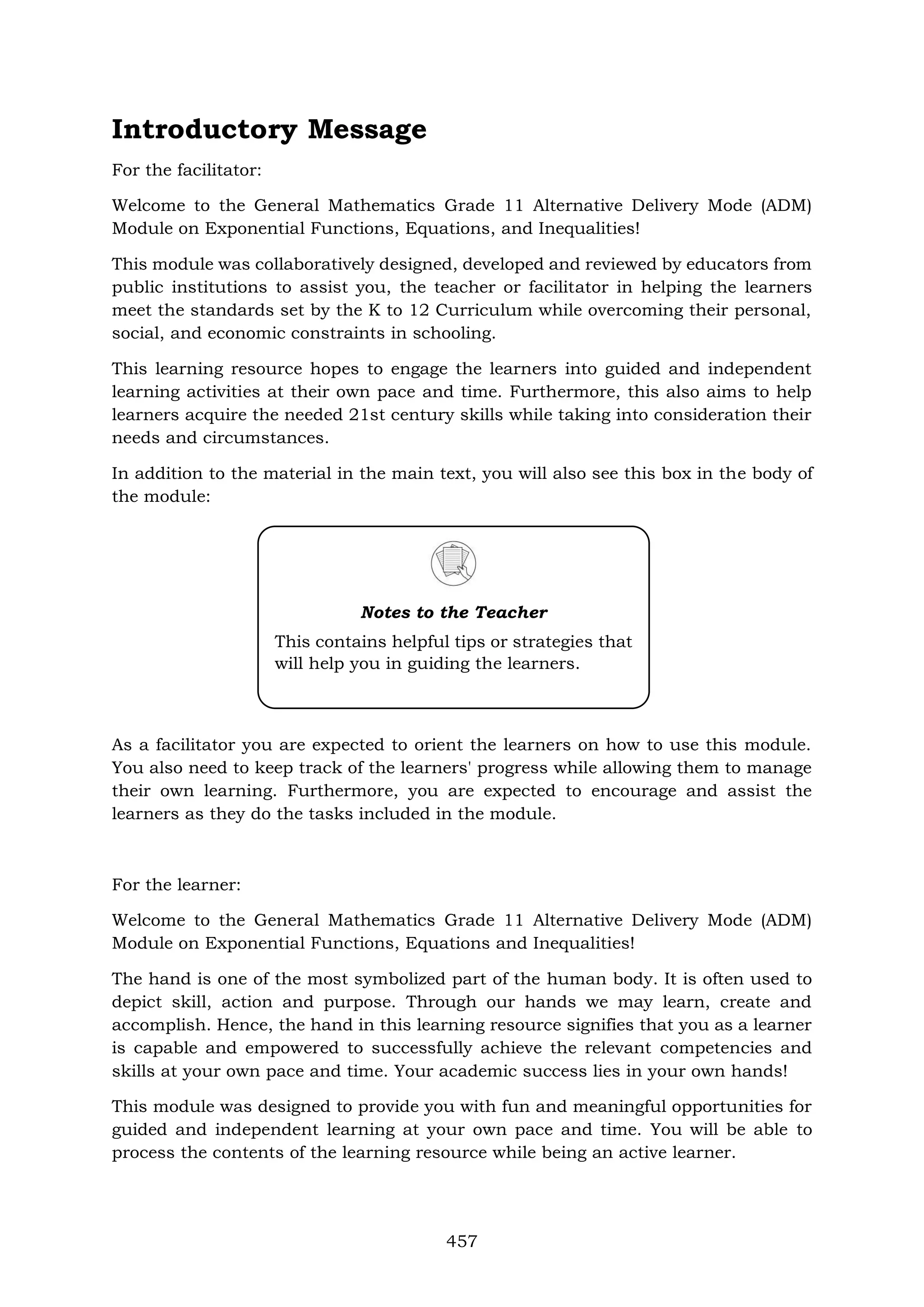
























![482
11.Which best leads to the correct answer in solving for the unknown variable
in the given exponential inequality in number 10?
a. 𝑥 − 5 < 𝑥 − 10
b. 𝑥 − 5 > 𝑥 − 10
c. 𝑥 − 5 < 2𝑥 − 20
d. 𝑥 − 5 > 2𝑥 − 20
12.What is the value of x for the given in number 10?
a. 𝑥 < 10
b. 𝑥 > 10
c. 𝑥 < 15
d. 𝑥 > 15
13. Which best describes base b of (
1
3
)
𝑥+4
≥ (
1
9
)
𝑥
?
a. 0 < 𝑏 < 1
b. 𝑏 < 1
c. 𝑏 > 1
d. 𝑏 > 0
14.Which of the following best leads to the value of x in (
1
3
)
𝑥+4
≥ (
1
9
)
𝑥
?
a. (
1
3
)
𝑥+4
≤ (
1
3
)
2𝑥
b. (
1
3
)
𝑥+4
≥ (
1
3
)
𝑥
c. (
1
3
)
𝑥+4
≥ (
1
3
)
−2𝑥
d. (
1
3
)
𝑥+4
≤ (
1
3
)
−2𝑥
15. What is the solution to (
1
3
)
𝑥+4
≥ (
1
9
)
𝑥
?
a. (4, +∞)
b. [4, +∞)
c. (−∞, 4)
d. (−∞, 4]](https://image.slidesharecdn.com/generalmathematics-230829050249-bdfea8c7/75/general-mathematics-pdf-485-2048.jpg)



![486
Example 3: Solve for the values of x in 5𝑥
> 125𝑥+8
Solution:
5𝑥
> (5)3(𝑥+8) Express 125 as 53
, for both sides of the inequality
to have same bases.
𝑥 > 3𝑥 + 24 𝑏 = 5. It is a fact that if 𝑏 > 1 and 𝑏𝑥1 > 𝑏𝑥2, then
𝑥1 > 𝑥2.
𝑥 − 𝑥 − 24 > 3𝑥 + 24 − 𝑥 − 24 Use Addition Property of Equality in order to solve
for the value of x.
−24 > 2𝑥
Combine like terms.
𝑥 < −12 Use Multiplication Property of Equality by
multiplying both sides of the equation by ½.
Hence, the solution to the exponential inequality 5𝑥
> 125𝑥+8
is the set of all
real numbers less than -12. In symbols, that is, 𝑥 < −12 or (−∞, −12).
Example 4: Solve for the values of x in (
1
7
)
2𝑥+9
≤ (
1
343
)
𝑥−5
.
Solution:
(
1
7
)
2𝑥+9
≤ (
1
7
)
3(𝑥−5)
Express
1
343
as (
1
7
)
3
, in order for both sides
of the inequality to have same bases.
2𝑥 + 9 ≥ 3𝑥 − 15 𝑏 =
1
7
. It is a fact that if 0 < 𝑏 < 1 and 𝑏𝑥1 <
𝑏𝑥2, then 𝑥1 > 𝑥2.
2𝑥 + 9 − 2𝑥 + 15 ≥ 3𝑥 − 15 − 2𝑥 + 15 Use Addition Property of Equality in order
to solve for the value of x.
24 ≥ 𝑥 or 𝑥 ≤ 24 Combine like terms.
Thus, the solution to the exponential inequality (
1
7
)
2𝑥+9
≤ (
1
343
)
𝑥−5
is the set
of all real numbers less than or equal to 24. In symbols, that is, 𝑥 ≤ 24 or (−∞, 24].
What’s More
Activity 18.1 Who Has a Point?
Observe each of the following pairs of solutions. Decide whether anyone of them got
the correct answer. Answer the sets of guide questions.
Becca Celia
16𝑥2
= 4𝑥+3
16𝑥2
= 4𝑥+3
(2)4𝑥2
= (2)2(𝑥+3)
(4)2𝑥2
= 4𝑥+3
4𝑥2
= 2𝑥 + 6 2𝑥2
= 𝑥 + 3
(
1
2
) (4𝑥2
− 2𝑥 − 6 = 0)
2𝑥2
− 𝑥 − 3 = 0
2𝑥2
− 𝑥 − 3 = 0 (2𝑥 − 3)(𝑥 + 1) = 0
(2𝑥 − 3)(𝑥 + 1) = 0 2𝑥 − 3 = 0 and 𝑥 + 1 = 0
2𝑥 − 3 = 0 and 𝑥 + 1 = 0 𝑥 =
3
2
, 𝑥 = −1
𝑥 =
3
2
, 𝑥 = −1](https://image.slidesharecdn.com/generalmathematics-230829050249-bdfea8c7/75/general-mathematics-pdf-489-2048.jpg)




![491
15. hat is the value of x for the given in number 12?
a. (−∞, 1)
b. (−∞, 1]
c. (1, +∞)
d. [1, +∞)
Additional Activities
Solve for the values of x in 323𝑥2
= 411𝑥+24
and in (
1
16
)
2𝑥+5
= (
1
64
)
𝑥−1
.](https://image.slidesharecdn.com/generalmathematics-230829050249-bdfea8c7/75/general-mathematics-pdf-494-2048.jpg)




































































![560
4. Find the x-intercept and y-intercept of 𝑓(𝑥) = −2(0.32𝑥+1
) + 4.
Solution:
To find the y-intercept, let x = 0, then by substitution, we have
𝑓(𝑥) = −2(0.32𝑥+1
) + 4
𝑓(0) = −2(0.32(0)+1
) + 4
𝑓(0) = −2[(
3
10
)−1
)
1
] + 4
𝑓(0) = −2 (
3
10
)
−1
+ 4
𝑓(0) = −2 (
10
3
) + 4
𝑓(0) = (
−20
3
) + 4
𝑓(0) = −
8
3
Then, the y-intercept is at (0, −
8
3
).
To find the x-intercept, let y = 0, then by substitution, we have
𝑓(𝑥) = −2(0.32𝑥+1
) + 4
𝑦 = −2(0.32𝑥+1) + 4
0 = −2(0.32𝑥+1
) + 4
4 = −2(0.32𝑥+1
)
22
= −2(0.32𝑥+1
)
Since no way could make their bases equal, there is no x-intercept.
Asymptotes of an Exponential Function Given by a Graph
A line that a curve approaches arbitrarily closely is an asymptote. An
asymptote may be vertical, oblique or horizontal. As for this topic, horizontal
asymptotes correspond to the value the curve approaches as x gets very large or very
small.
With the help of a table of values and a graph you can determine the asymptote
of an exponential function. Let us first take a look at the properties of the function
f(𝑥) = 2𝑥. In this case, a = 1, P(x) = x, and h = 0.
Assign integer values to x and find the corresponding values of f(x).
For x ≥ 0:
x 0 1 2 3 4 5 6 7 8 9
f(x) 1 2 4 8 16 32 64 128 256 512
Please take note, that as x increases, the value of f(x) keeps on increasing
rapidly.](https://image.slidesharecdn.com/generalmathematics-230829050249-bdfea8c7/75/general-mathematics-pdf-563-2048.jpg)














































![607
Example 2
The intensity of sound of a lawn mower is 10−3
watts/𝑚2
. (a) What is the
corresponding sound intensity in decibels? (b) How much more intense is this sound
than the least audible sound a human can hear?
Solution:
(a) Since 𝑙 = 10−3
𝑡ℎ𝑒𝑛 𝐷 = 10 log
10−3
10−12
𝐷 = 10 log 109
By, definition 𝒍𝒐𝒈 𝟏𝟎𝟗
is the exponent by which 10 must be raised to
obtain 109
, so 𝑙𝑜𝑔 109
=9
𝐷 = 10(9)
𝐷 = 90 𝑑𝑒𝑐𝑖𝑏𝑒𝑙𝑠
(b) This sound is
10−3
10−12 = 109 = 1,000,000,000 times more intense than the
least audible sound a human can hear
pH Scale
Acidic and basic are two extremes that describe a chemical property. Mixing acids
and bases can cancel out or neutralize their extreme effects. A substance that is
neither acidic nor basic is neutral.
The pH scale measures how acidic or basic a substance is. The pH scale ranges from
0 to 14. A pH of 7 is neutral. A pH less than 7 is acidic. A pH greater than 7 is basic.
The pH level of a water-based solution is defined as
𝒑𝑯 = −𝒍𝒐𝒈[𝑯+]
where [𝐻+] is the concentration of hydrogen ions in moles per liter.
Example 3
A 1-liter solution contains 0.01 moles of hydrogen ions. Determine and describe its
pH level.
Solution:
Since there are 0.01 moles of hydroegen ions in 1 liter, then the concentration
of hydrogen ions is 10−2
moles per liter. The pH level is − log 10−2
. By, definition
𝒍𝒐𝒈 𝟏𝟎−𝟐
is the exponent by which 10 must be raised to obtain 10−2
, so 𝑙𝑜𝑔 10−2
=
−2,
So, 𝑝𝐻 = −(−2) = 2, therefore, the pH level is 2
Since the pH level is 2, then it is acidic.
The application of logarithmic function will further discuss on the lesson solving real-
life problems involving logarithmic functions, equations and inequalities.](https://image.slidesharecdn.com/generalmathematics-230829050249-bdfea8c7/75/general-mathematics-pdf-610-2048.jpg)















































































![687
Activity 1.3
Determine the domain and range of the following:
1. 𝑓(𝑥) = (3 − 2𝑥)
2. 𝑓(𝑥) =𝑙𝑜𝑔 𝑙𝑜𝑔 (𝑥) − 5
3. 𝑓(𝑥) = (𝑥 + 2) + 4
4. 𝑓(𝑥) = (𝑥 + 1) − 2
5. 𝑓(𝑥) = (4 − 7𝑥)
What I Have Learned
1. The __________ of a function is the set of all possible values of the
independent variable ____. These possible values are often known as
_________.
2. The ________ of a function is the set of all possible values of the dependent
variable ____. These possible values are often known as ________.
3. The ________________ 𝑓(𝑥) = 𝑥 is the inverse of _____________________
𝑓(𝑥) = 𝑏𝑥.
4. The domain of the function 𝑓(𝑥) = 𝑥 is ________ while its range is ________.
What I Can Do
Answer the problem given below.
Loudness is measured in decibels. The formula for the loudness of a sound
is given by "dB = 10
𝑙𝑜𝑔𝑙𝑜𝑔 𝐼
𝐼0
" where I0 is the intensity of "threshold sound", or sound
that can barely be perceived. Other sounds are defined in terms of how many times
more intense they are than threshold sound. For instance, a cat's purr is
about 316 times as intense as threshold sound, for a decibel rating of:
dB = 10
𝑙𝑜𝑔𝑙𝑜𝑔 𝐼
𝐼0
= 10
𝑙𝑜𝑔𝑙𝑜𝑔 (316 𝐼0)
𝐼0
= 10log[ 316 ]
= 24.9968708262...,...or 25 decibels.
Considering that prolonged exposure to sounds above 85 decibels can cause
hearing damage or loss, and considering that a gunshot from a .22 rimfire rifle has
an intensity of about I = (2.5 ×1013)I0, should you follow the rules and wear ear
protection when relaxing at the rifle range?](https://image.slidesharecdn.com/generalmathematics-230829050249-bdfea8c7/75/general-mathematics-pdf-690-2048.jpg)


















![706
Activity 1.3
Determine the x-intercepts, zeroes and vertical asymptotes of the following:
1. 𝑓(𝑥) = 𝑥
2. 𝑓(𝑥) =𝑙𝑜𝑔 𝑙𝑜𝑔 (𝑥) − 3
3. 𝑓(𝑥) = (𝑥 − 2) + 4
4. 𝑓(𝑥) = (𝑥 + 1) − 2
5. 𝑓(𝑥) = (𝑥 ) + 2
What I Have Learned
Complete the following statement with correct word/s.
1. The logarithmic function ____________ is the inverse of 𝑓(𝑥) = 𝑏𝑥
.
2. An ___________ is where the functions cross the x or y-axis and __________ is
where the curve cross the x-xis.
3. An ___________ is a line that a curve approaches as it approaches___________.
4. The ________ of a function is the x-value that makes the function equal to
___________.
5. A logarithmic function is __________ on negative numbers and________.
What I Can Do
Answer the problem given below.
pH Level In chemistry, the pH of a substance is defined as 𝑝𝐻 = − 𝑙𝑜𝑔 𝑙𝑜𝑔 [𝐻+
]
where H+ is the hydrogen ion concentration, in moles per liter. Find the pH level
of each substance.
SUBSTANCE
HYDROGEN ION
CONCENTRATION
a.) Pineapple juice
b.) Hair conditioner
c.) Mouthwash
d.) Eggs
e.) Tomatoes
1.6 x 10-4
0.0013
6.3 x 10-7
1.6 x 10-8
6.3 x 10-5](https://image.slidesharecdn.com/generalmathematics-230829050249-bdfea8c7/75/general-mathematics-pdf-709-2048.jpg)




















![727
What I Have Learned
A. Please read the sentences carefully and fill in the missing word/s by writing your
answer on the line/s provided.
1. Logarithmic equation is a ______________________________________________.
2. Logarithmic inequality is a _____________________________________________.
3. Logarithmic function is a _______________________________________________.
4. Logarithmic function is the ____________________ of exponential function.
B. Give at least three examples of real-life situations which can be modelled by a
logarithmic functions, equations or inequalities.
What I Can Do
Read and analyze the situation below then answer the question given.
Exponential function cannot be separated in solving problems involving logarithmic
function. Most of the time, professionals like chemists, engineers, and scientists
encounter problems that require the application of exponential and logarithmic
functions.
Chemists define the acidity or alkalinity of a substance according to the formula "pH
= –log[H+]" where [H+] is the hydrogen ion concentration, measured in moles per liter.
Solutions with a pH value of less than 7 are considered acidic while solutions with a
pH value of greater than 7 are basic. On the other hand, solutions with a pH of 7
(such as pure water) are neutral. Suppose that you test apple juice and find that the
hydrogen ion concentration is [H+] = 0.0003. Find the pH value and determine
whether the juice is basic or acidic.
Here are the steps to solve the problem and the rubric that will guide you in giving
the correct solution to the problem.
Steps in Problem Solving Possible Highest
Points
Your
Score
1. Give the Appropriate model or equation to
find the pH Level.
2 points
2. Identify the given 2 points
3. Substitute the given and show the solution 3 points
4. Give the final answer 3 points
Total 10 points](https://image.slidesharecdn.com/generalmathematics-230829050249-bdfea8c7/75/general-mathematics-pdf-730-2048.jpg)





